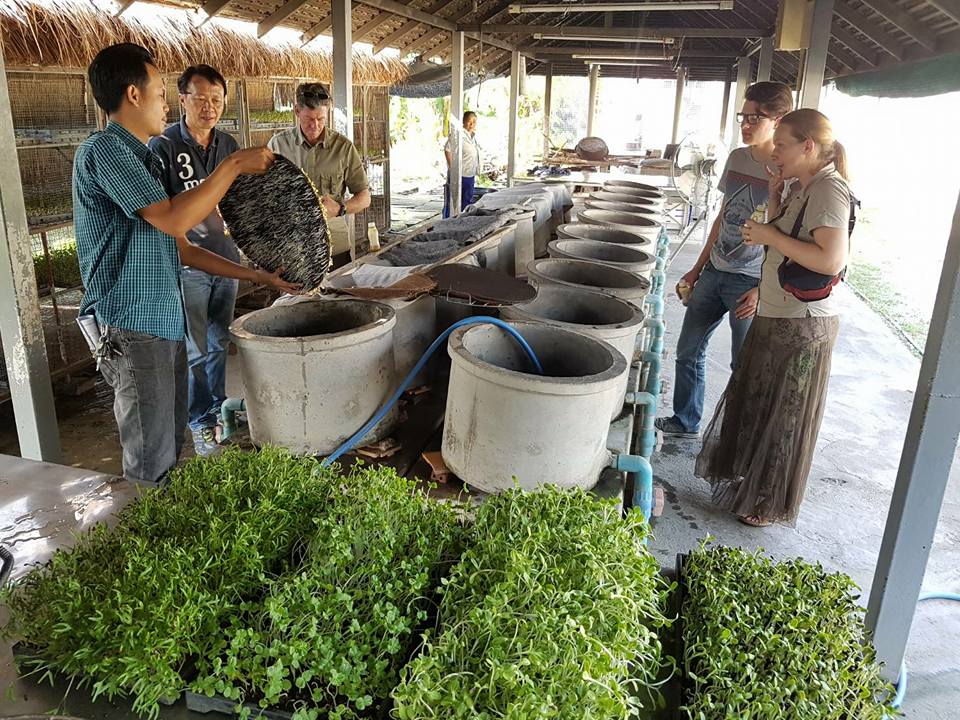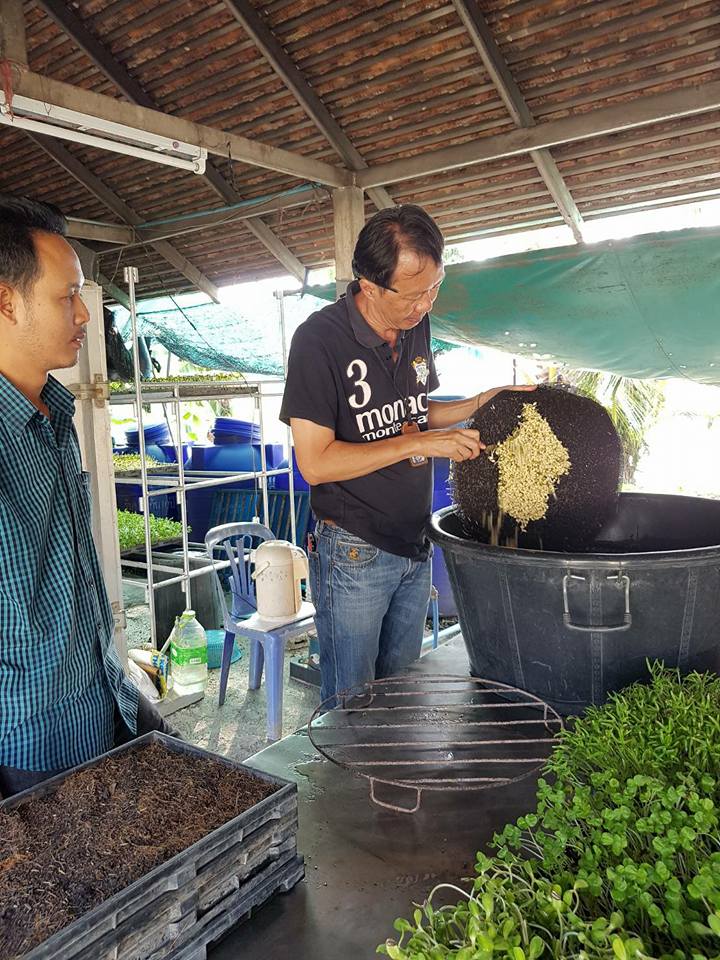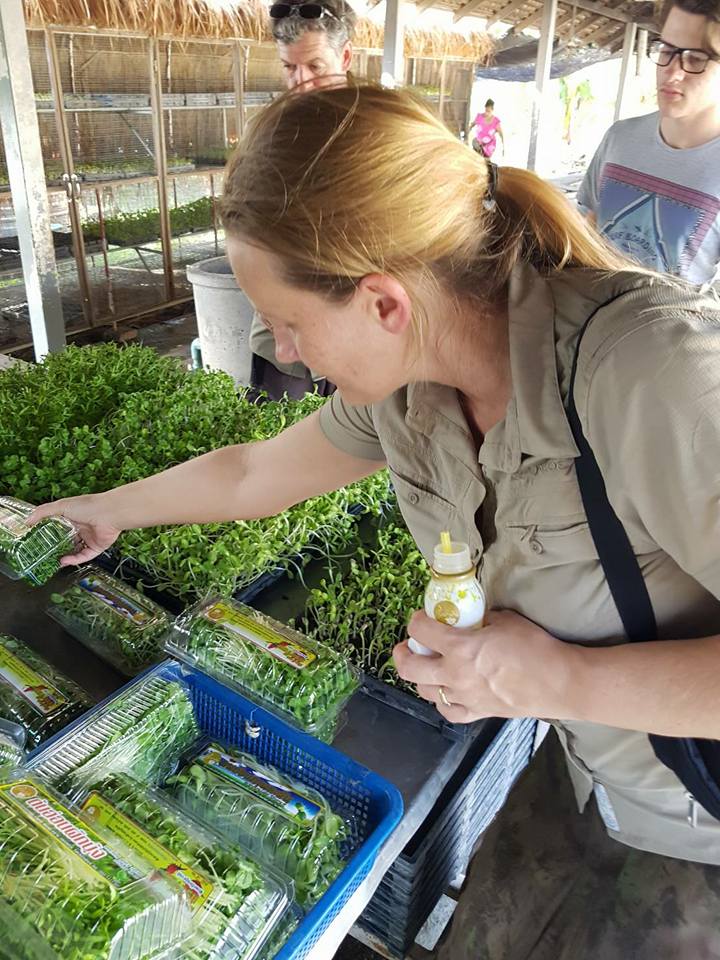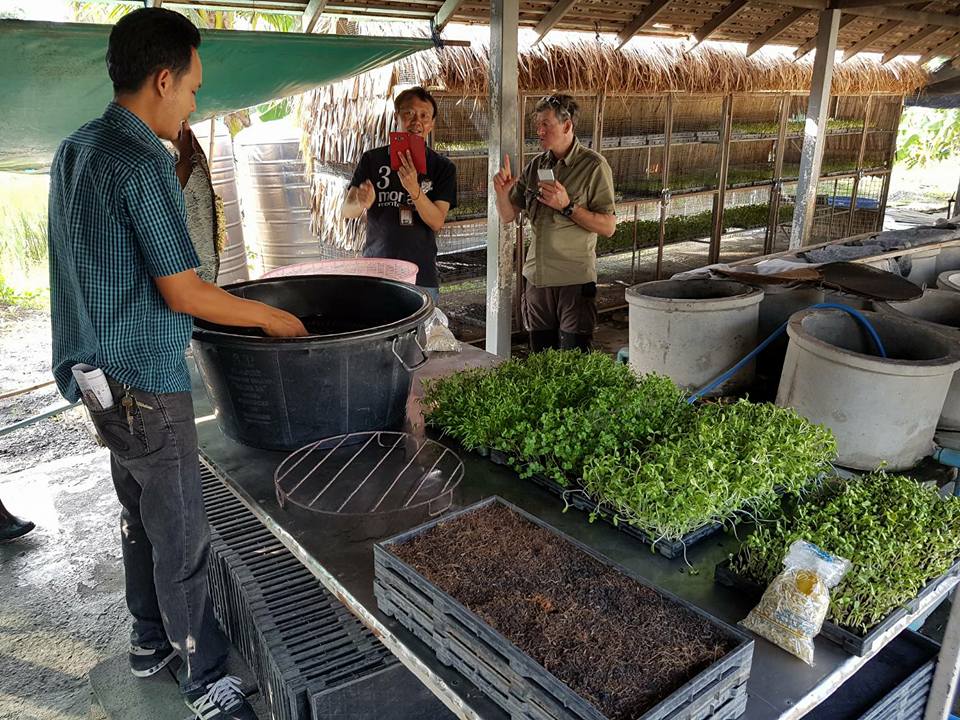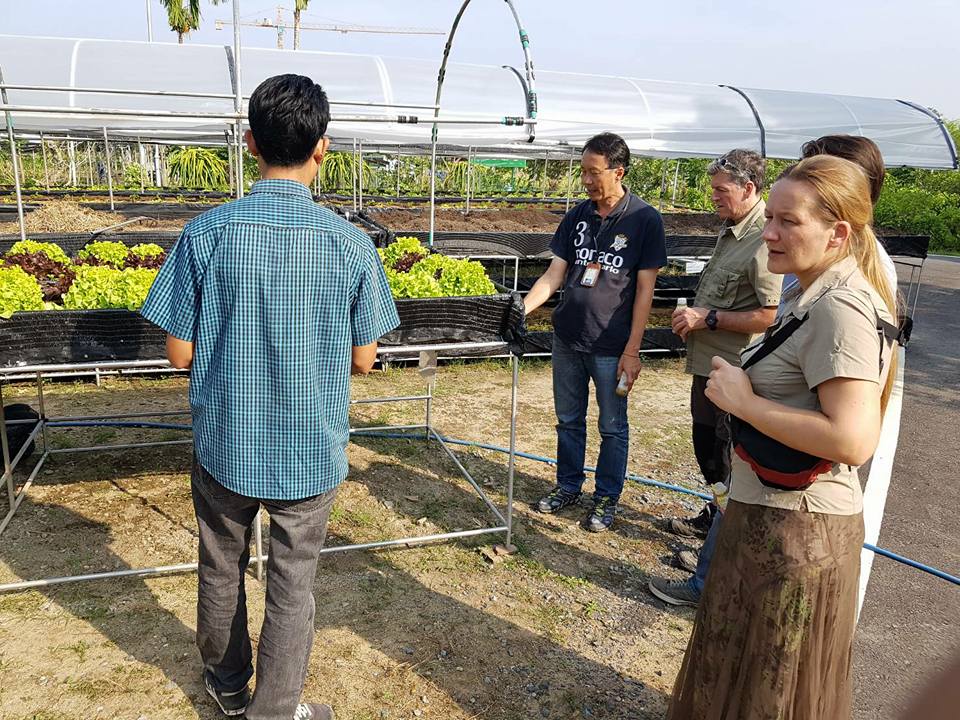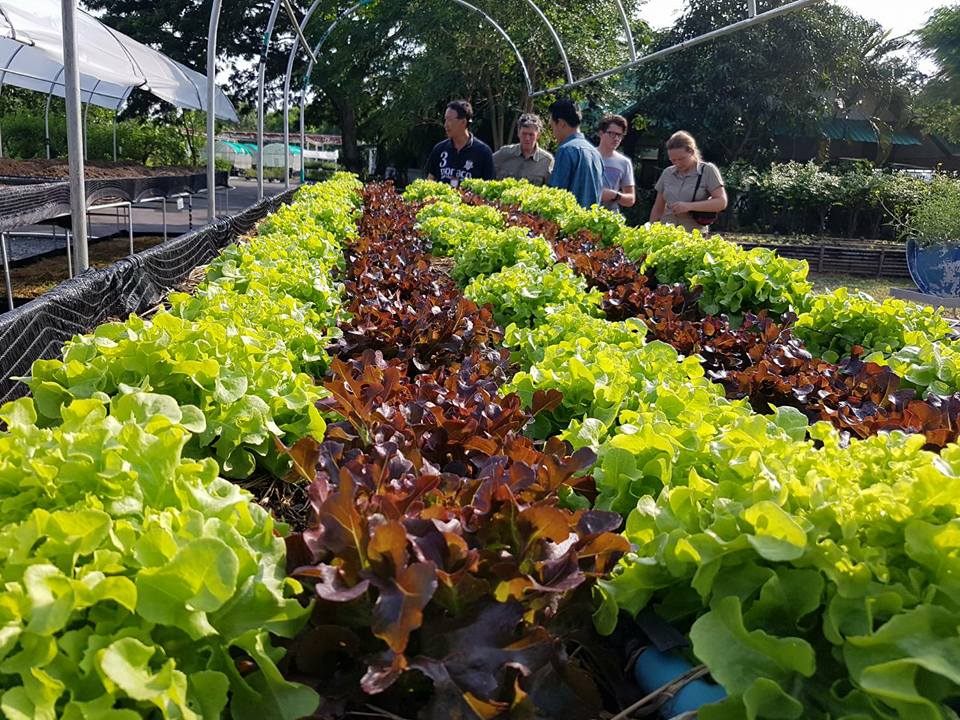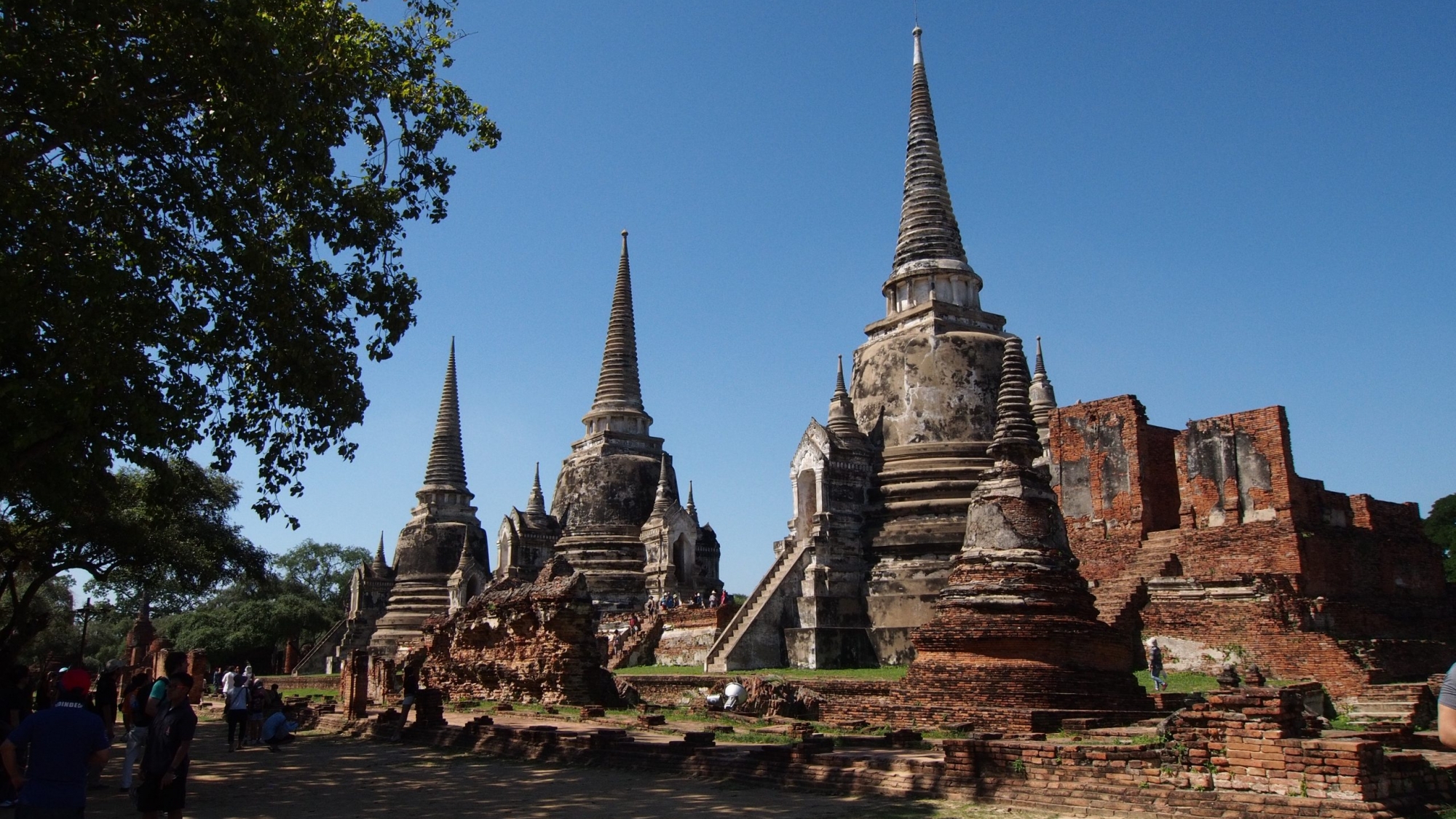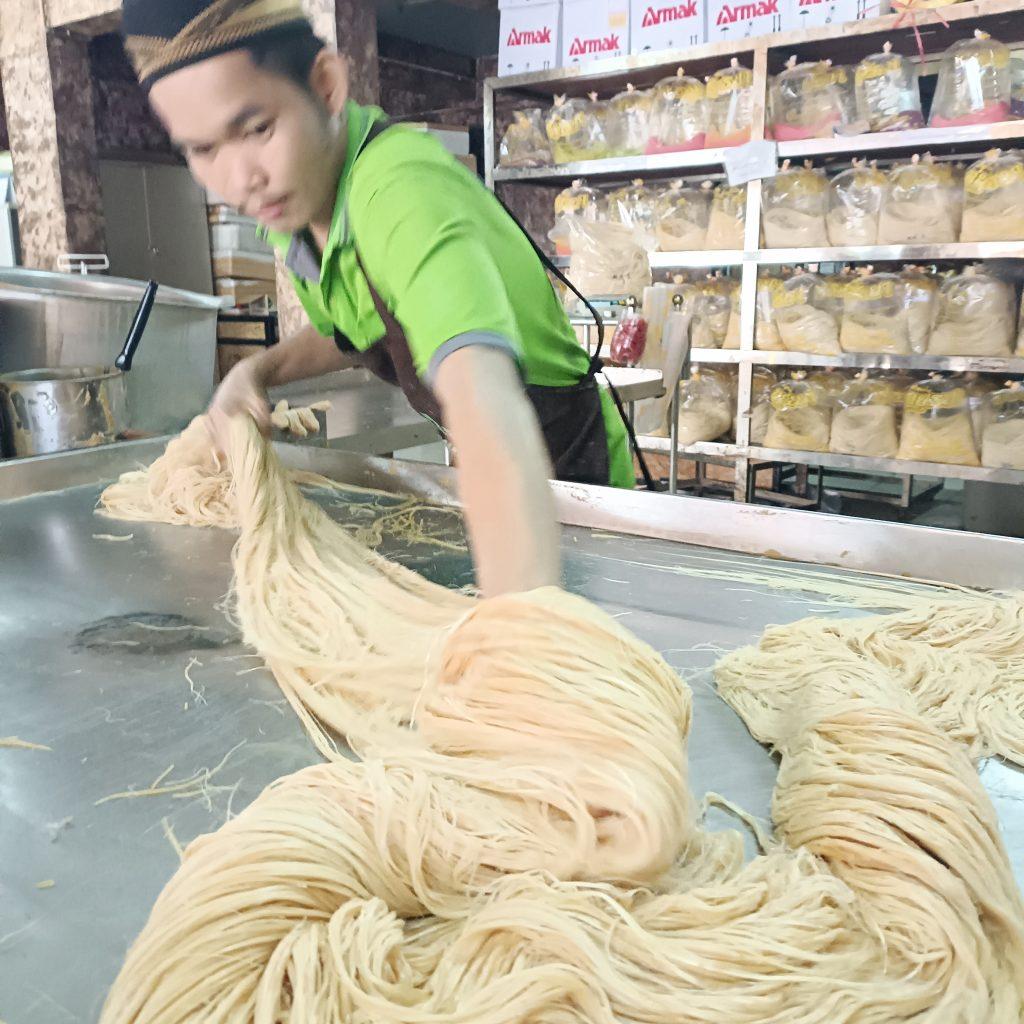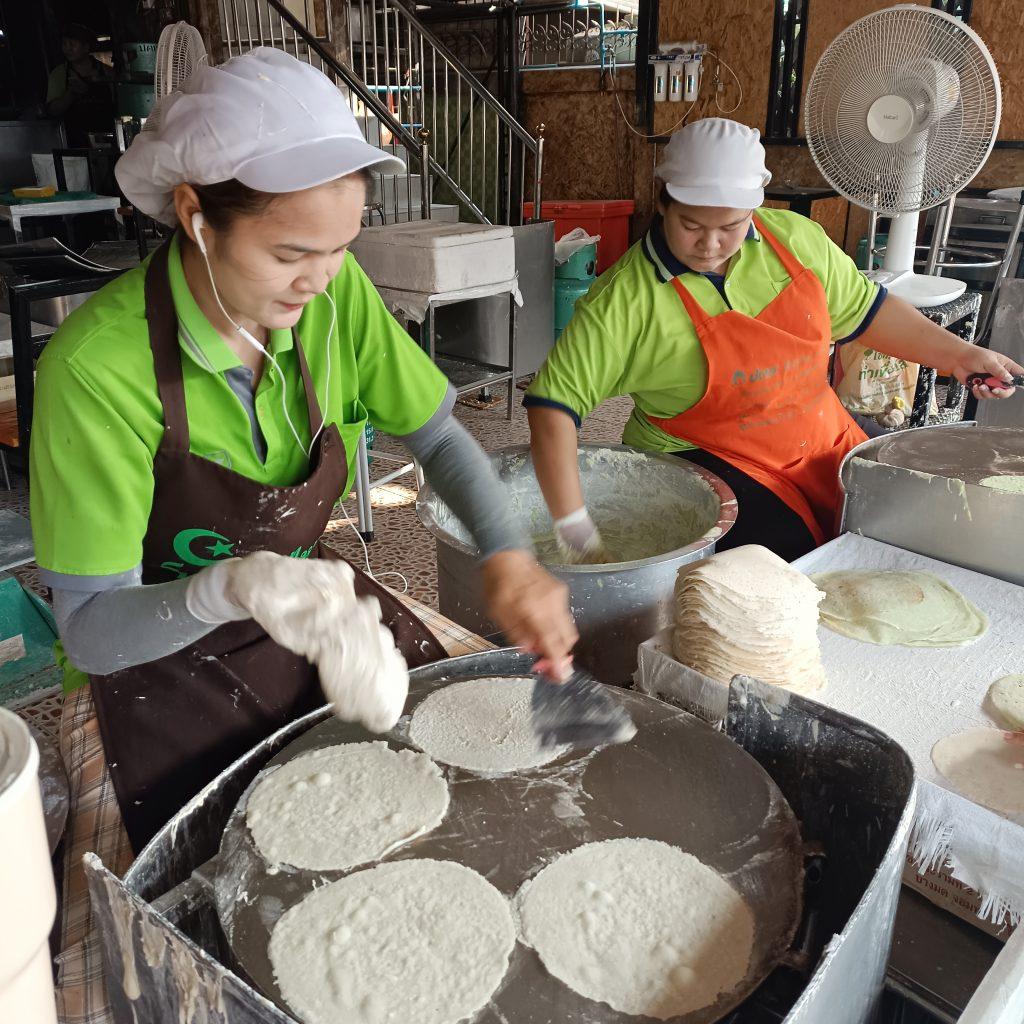When it comes to Historical buildings, Ayutthaya Travel is well known for temples and palaces. But in addition to that, a variety of Food is also another magnet. You can find fresh River prawns, fish, noodles, and even the never-miss dessert like cotton candy wrap. So, remember to plan your eating Trip whenever you visit Ayutthaya.
Ayutthaya is one of Thailand’s Historical and majestic highlights. The capital of Thailand, then known as the Kingdom of Ayutthaya, Phra nakhon Si Ayutthaya was a glorified as one of the biggest cities in Southeast Asia and a regional power for 417 years.
Visitors can explore and appreciate Thai History in Phra nakhon Si Ayutthaya, which is only 86 kilometres north of Bangkok. Visitors to Ayutthaya can marvel at its grandeur reflected through numerous magnificent temples and ruins concentrated in and around the City, which is located upon an “Island” surrounded by the Chao Phraya, Pa Sak and Lopburi Rivers.
Although there are numerous attractions, the Phra nakhon Si Ayutthaya Historical Park in the heart of Ayutthaya City is a UNESCO’s World Heritage site and a wonder to behold.
The ruins that now remain, many of which have been painstakingly restored, have been granted World Heritage status by UNESCO. The architecture of Ayutthaya is a fascinating mix of Khmer and early Sukhothai styles. Some cactus-shaped obelisks, called prangs, denote Khmer influence and look something like the famous towers of Angkor Wat. The more pointed stupas are ascribed to the Sukhothai influence.
When it comes to Historical buildings, Ayutthaya Travel is well known for temples and palaces. But in addition to that, a variety of Food is also another magnet. You can find fresh River prawns, fish, noodles, and even the never-miss dessert like cotton candy wrap. So, remember to plan your eating Trip whenever you visit Ayutthaya.
Ayutthaya is one of Thailand’s Historical and majestic highlights. The capital of Thailand, then known as the Kingdom of Ayutthaya, Phra nakhon Si Ayutthaya was a glorified as one of the biggest cities in Southeast Asia and a regional power for 417 years.
Visitors can explore and appreciate Thai History in Phra nakhon Si Ayutthaya, which is only 86 kilometres north of Bangkok. Visitors to Ayutthaya can marvel at its grandeur reflected through numerous magnificent temples and ruins concentrated in and around the City, which is located upon an “Island” surrounded by the Chao Phraya, Pa Sak and Lopburi Rivers.
Although there are numerous attractions, the Phra nakhon Si Ayutthaya Historical Park in the heart of Ayutthaya City is a UNESCO’s World Heritage site and a wonder to behold.
The ruins that now remain, many of which have been painstakingly restored, have been granted World Heritage status by UNESCO. The architecture of Ayutthaya is a fascinating mix of Khmer and early Sukhothai styles. Some cactus-shaped obelisks, called prangs, denote Khmer influence and look something like the famous towers of Angkor Wat. The more pointed stupas are ascribed to the Sukhothai influence.
When it comes to Historical buildings, Ayutthaya Travel is well known for temples and palaces. But in addition to that, a variety of Food is also another magnet. You can find fresh River prawns, fish, noodles, and even the never-miss dessert like cotton candy wrap. So, remember to plan your eating Trip whenever you visit Ayutthaya.
Ayutthaya is one of Thailand’s Historical and majestic highlights. The capital of Thailand, then known as the Kingdom of Ayutthaya, Phra nakhon Si Ayutthaya was a glorified as one of the biggest cities in Southeast Asia and a regional power for 417 years.
Visitors can explore and appreciate Thai History in Phra nakhon Si Ayutthaya, which is only 86 kilometres north of Bangkok. Visitors to Ayutthaya can marvel at its grandeur reflected through numerous magnificent temples and ruins concentrated in and around the City, which is located upon an “Island” surrounded by the Chao Phraya, Pa Sak and Lopburi Rivers.
Although there are numerous attractions, the Phra nakhon Si Ayutthaya Historical Park in the heart of Ayutthaya City is a UNESCO’s World Heritage site and a wonder to behold.
The ruins that now remain, many of which have been painstakingly restored, have been granted World Heritage status by UNESCO. The architecture of Ayutthaya is a fascinating mix of Khmer and early Sukhothai styles. Some cactus-shaped obelisks, called prangs, denote Khmer influence and look something like the famous towers of Angkor Wat. The more pointed stupas are ascribed to the Sukhothai influence.
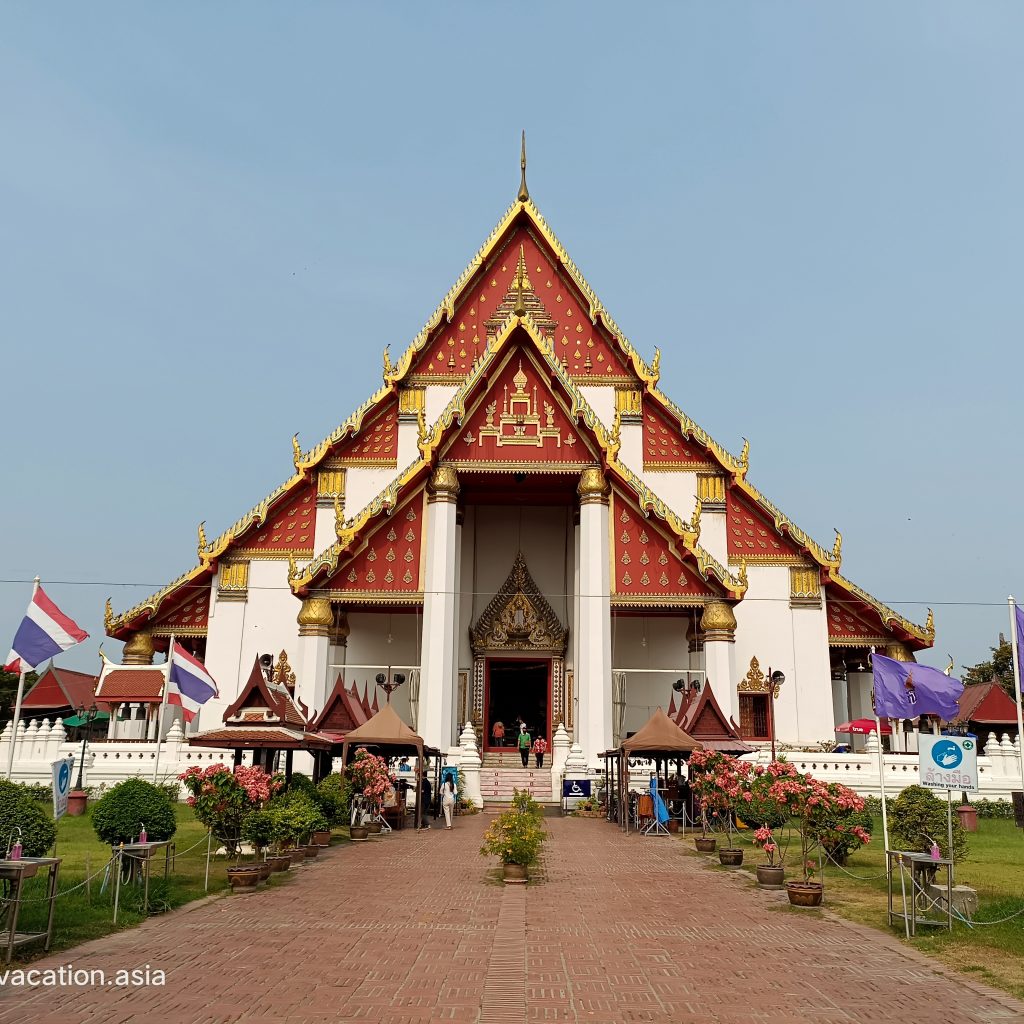
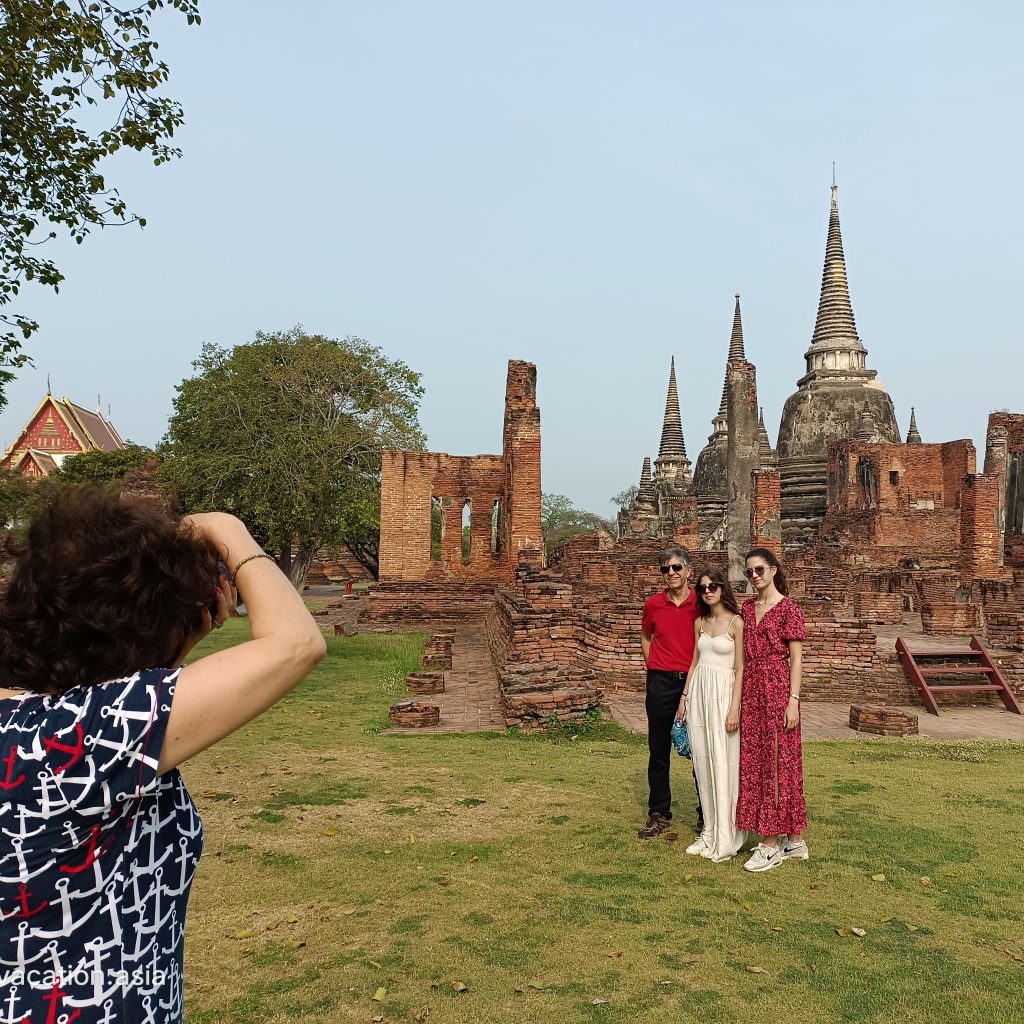
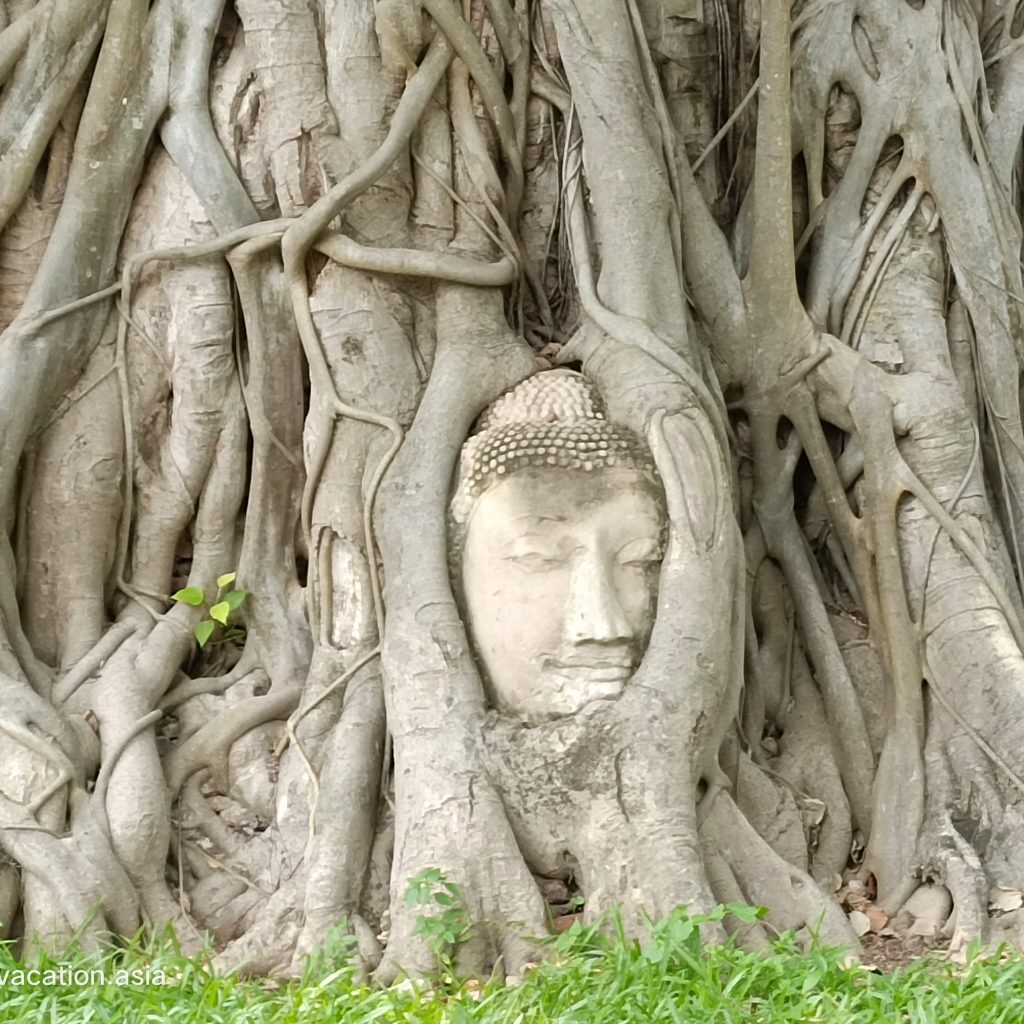
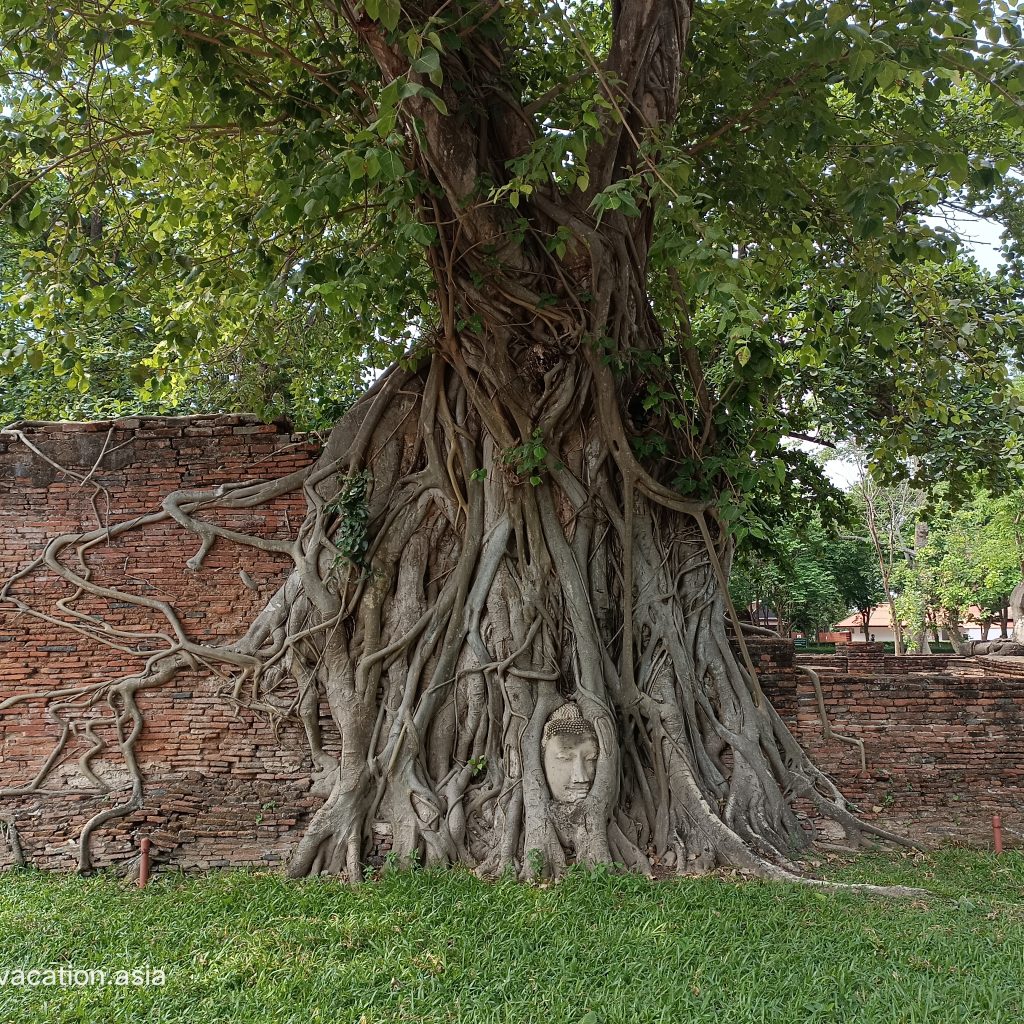
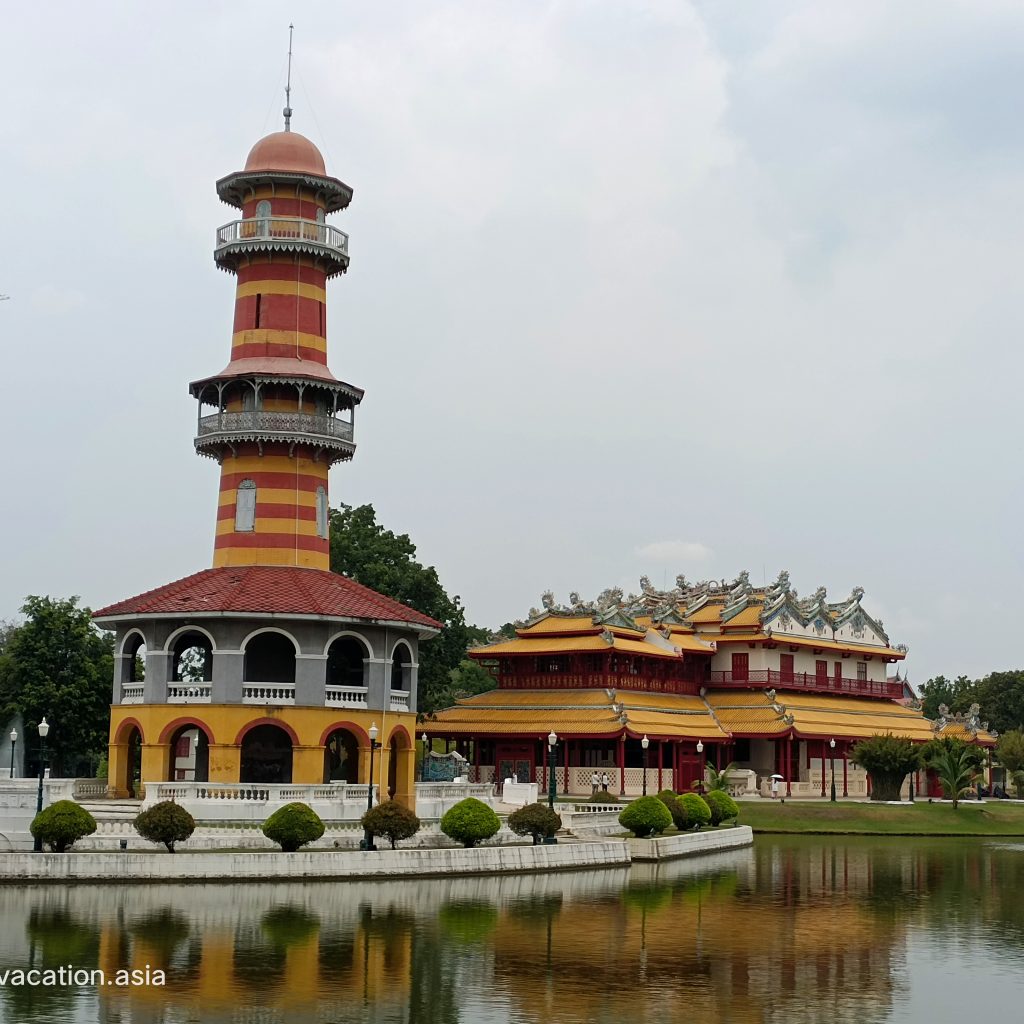
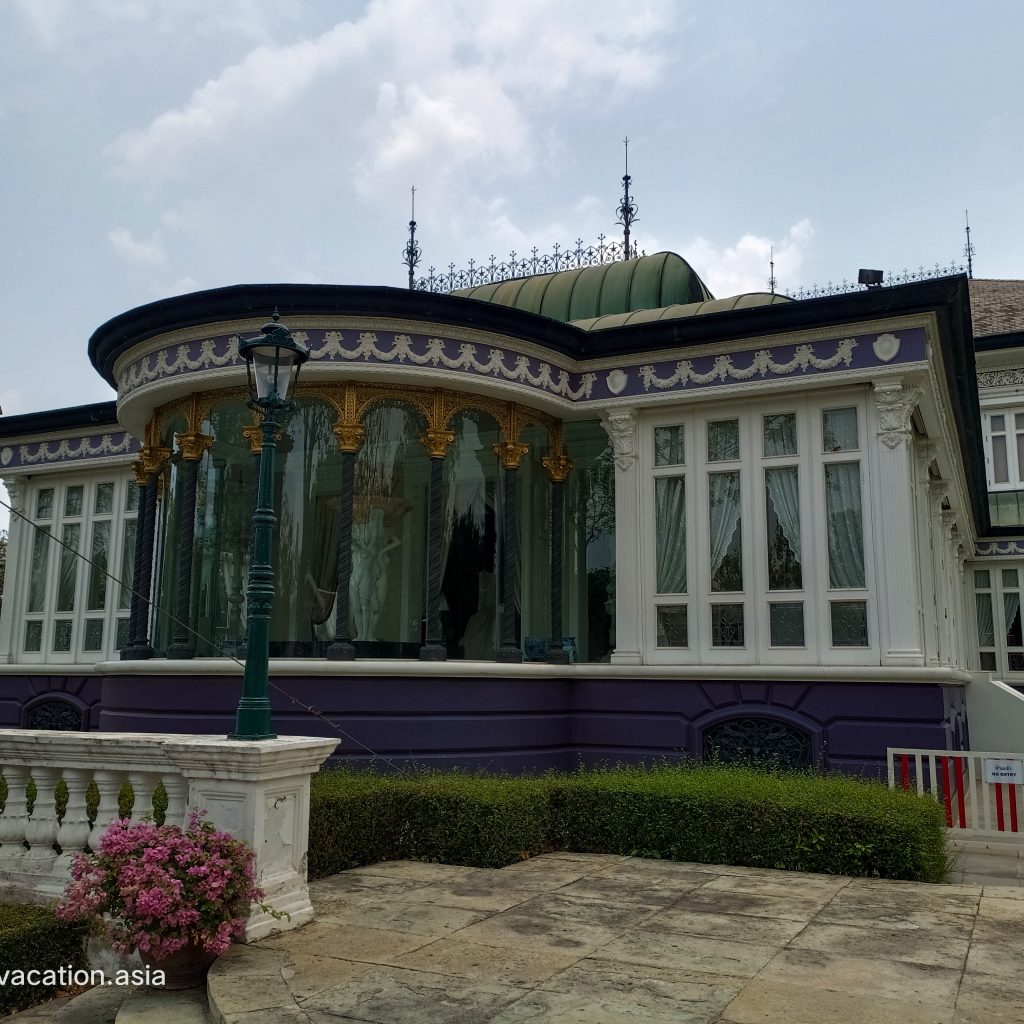
PLACE TO VISIT:-
1. Wat Chaiwatthanaram
Located on the bank of the Maenam Chao Phraya, to the west of the City Island is Wat Chaiwatthanaram. Built-in 1630 by King Prasat Thong to honor his mother, Wat Chai Wattanaram was conceived as a replica of the Angkor Temple.
One of the most visited historical site of Ayutthaya, Wat Chaiwattanaram rests on the bank of the Chao Phraya river, to the west of the City Island. The Temple was ordered to built in 1630 by King Prasat Thong to honor his mother, featuring the architectural style influenced by Angkor temple in Cambodia-its unique feature is a large, central prang (Khmer-style pagoda) surrounded by smaller prangs, symbolizing Mount Sumeru, the gods’ mountain according to Hindu belief. The lighting at night makes the temple even more exotic and beautiful.
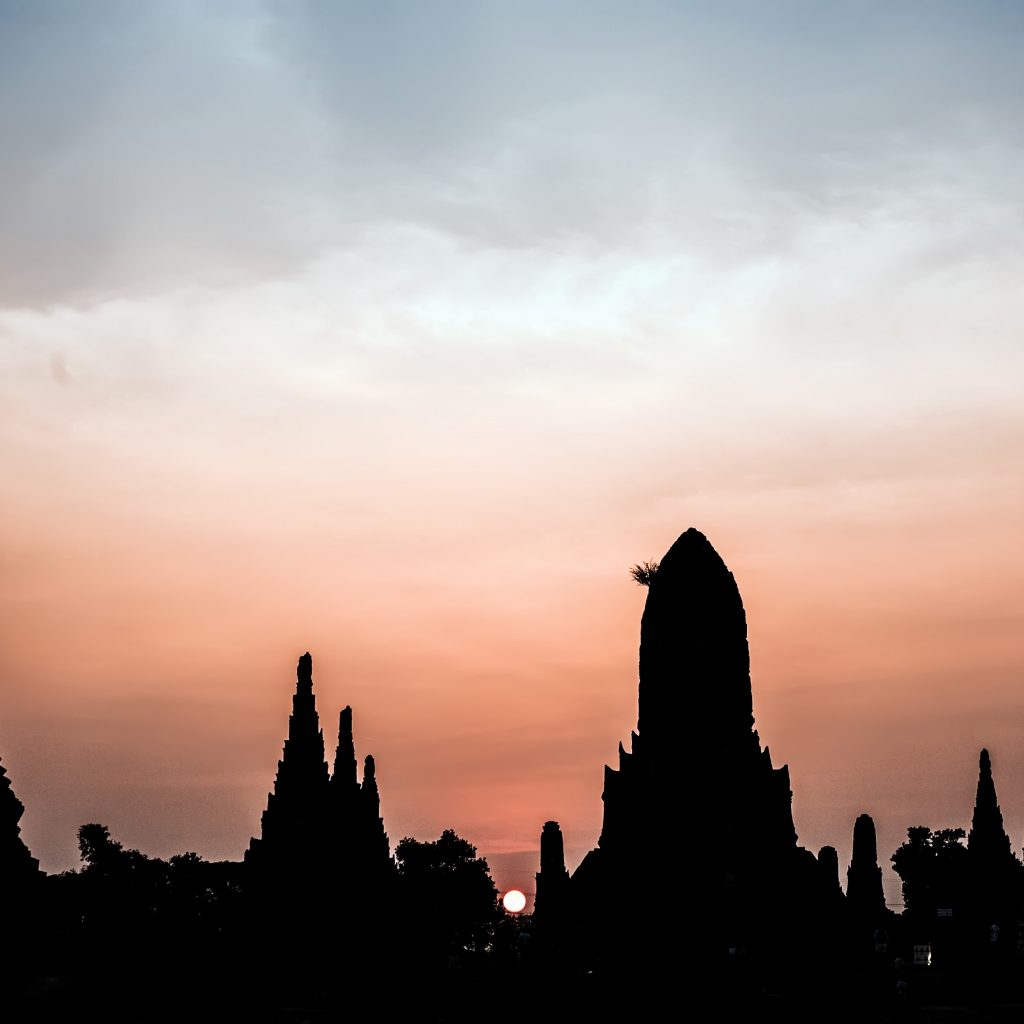
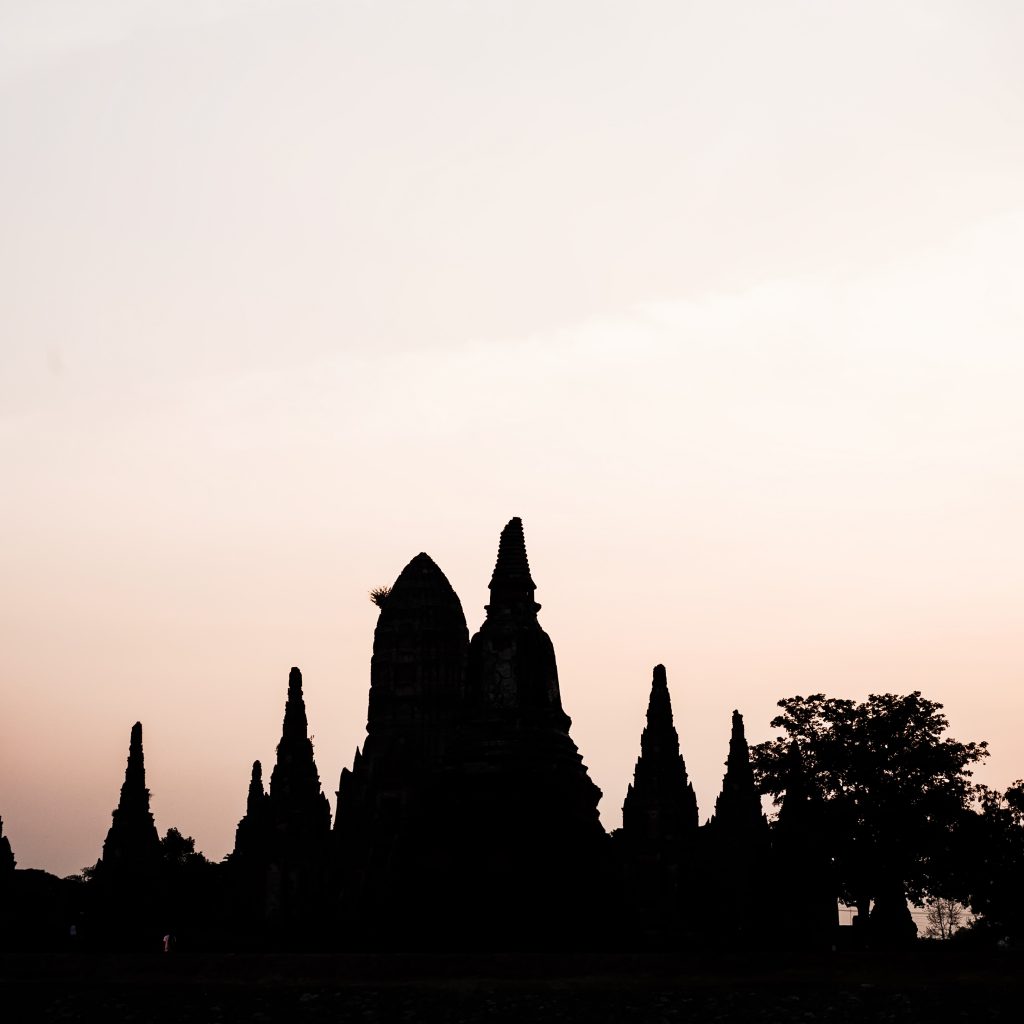

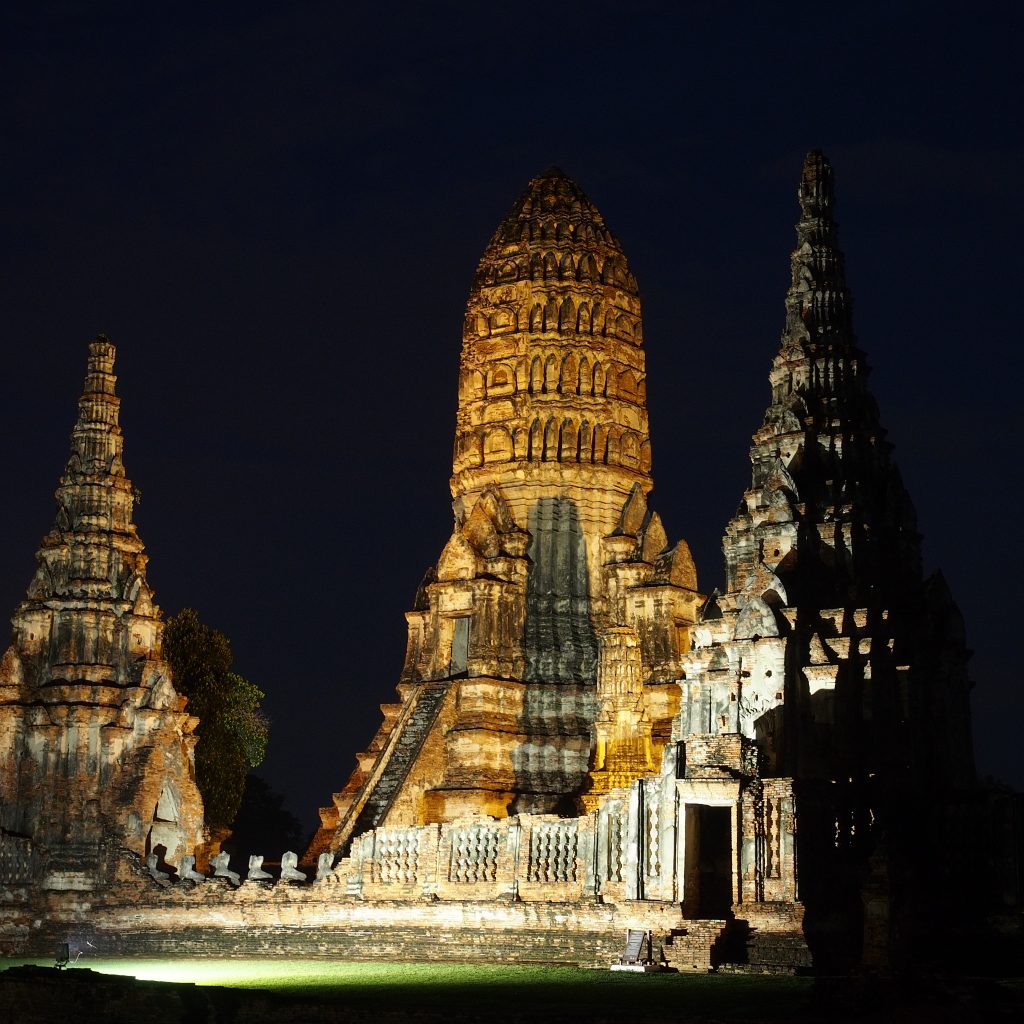
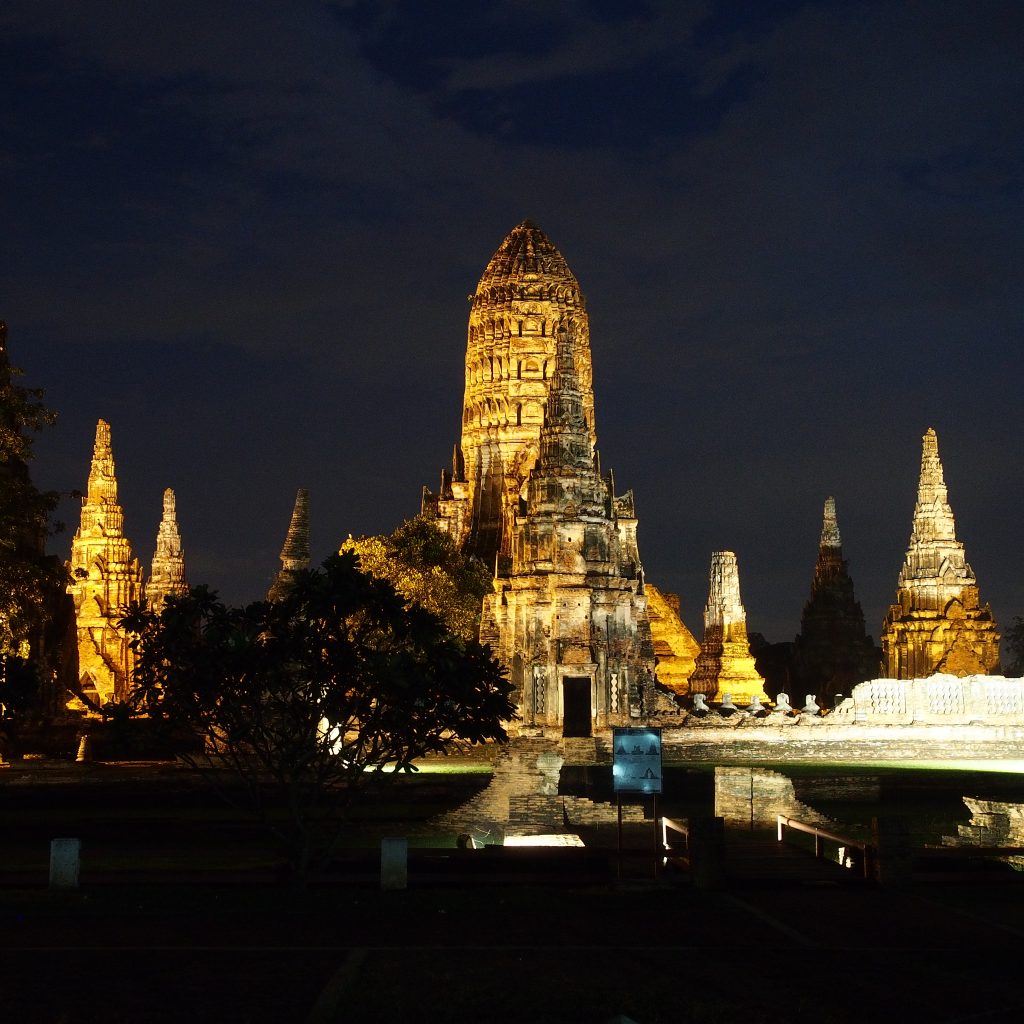
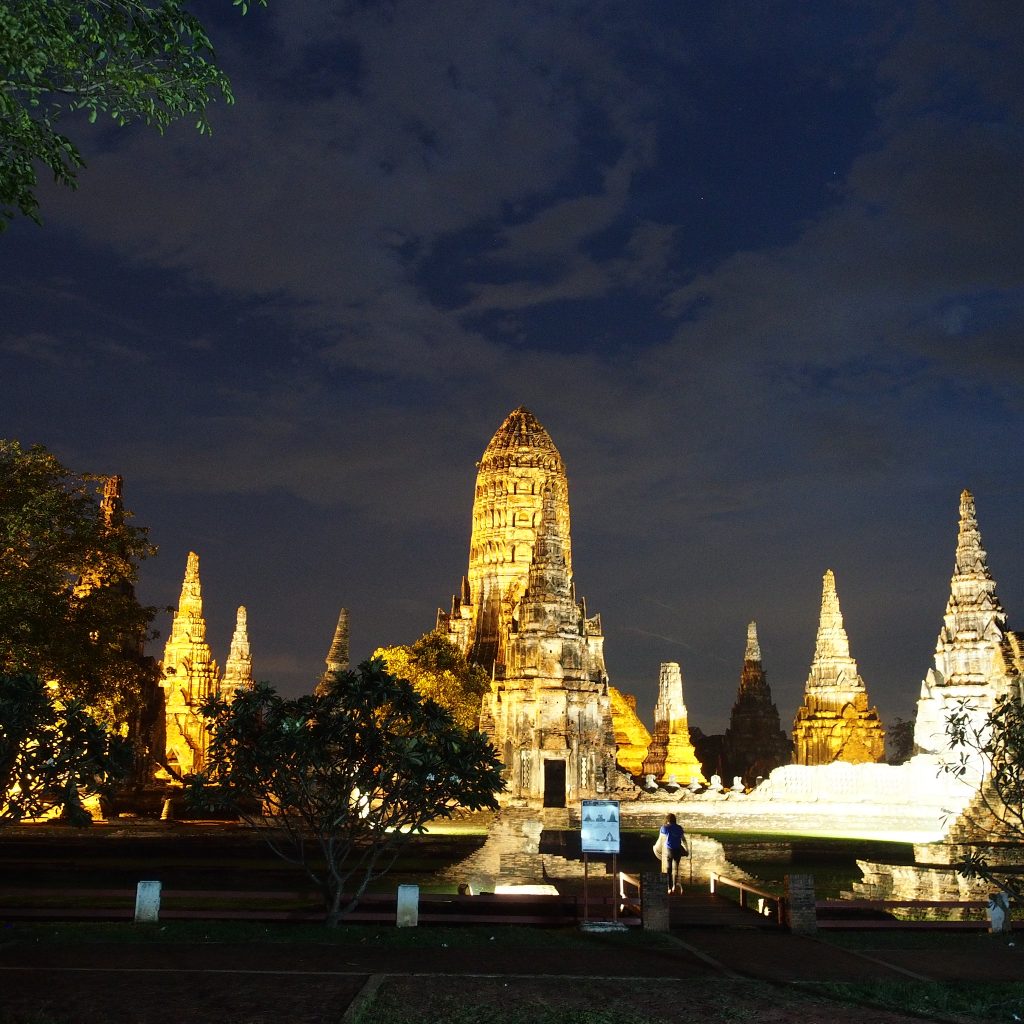
2. Wat Phra Si Sanphet
In 1491, Wat Phra Si Sanphet was located inside the compound of the Grand Palace-the foundations of which are still visible-and served as the royal Chapel, as Wat Phra Kaeo does in Bangkok. This Wang Lung Palace (Royal Palace) was built by King U-Thong upon the founding of the City. Used as a residential palace, it became a monastery in the reign of King Ramathibodi I. When King Borom Trai Lokanat commanded the construction of new living quarters, this residential palace was transformed into a Temple and the establishment of Wat Phra Si Sanphet. In Ayutthaya’s heyday, this was the largest temple in the city. The three main chedis which have been restored contain the ashes of three Ayutthaya kings. The temple is situated at the northern end of Si Sanphet Road. The royal chapel does not have any monks or novice inhabitants. The admission fee is 20 baht.
Wat Phra Sri Sanphet is located in the Pratu Chai subdistrict, Phra Nakorn Si Ayutthaya district, Ayutthaya province. The Temple is not only a significant historical site but has also been considered the spiritual center of Thais for a long time. Situated within the royal Palace grounds, Wat Phra Sri Sanphet is the royal monastery and therefore no monk is allowed to reside. However, the temple served to conduct ceremonies within the royal court, such as the ritual to drink an oath of allegiance. It is also regarded as an equivalence of Wat Mahathat in Sukhothai and a model for Wat Phra Sri Ratana Sasadaram (the royal temple of the Emerald Buddha) or Wat Phra Kaew in Bangkok. Somdet Phra Ramathibodi I or King U-thong commanded the construction of his royal house in this area, but when Somdet Phra Borom Tilokkanat succeeded the throne, the king considered moving the royal palace further north and converting the piece of land into a sacred ground which later became this temple. During the reign of Ramathibodi II, an enormous Buddha image was cast. The Buddha image of Phra Sri Sanphetdayan is 16 meters high and its surface is coated with 143 kilograms of gold. It had been enshrined inside the assembly hall until the fall of Ayutthaya in 1767 when the Burmese invaded and melted the gilded gold away. The Buddha image was seriously damaged, so in the Rattanakosin period, Phra Bat Somdet Phra Buddha Yodfa Chulaloke installed the broken core of Phra Sri Sanphetdayan in a pagoda inside Wat Phra Chetupon Vimolmangkalararm Rajvoramahaviharn in Bangkok and named the pagoda Chedi Sri Sanphetdayan. Somdet Phrachaoyuhua Borommakot was the first to command the temple restoration. During the reign of Phrabat Somdet Phra Chulachomklao Chao Yuhua (King Rama V), Phraya Boran Rachathanin the regional intendant found a considerably large collection of artifacts in the underground chamber of the pagoda, for example, Buddha images and gold ornaments. Later Field Marshal P. Piboonsongkram assigned a committee to renovate the ruins until the temple regained its current condition. This royal monastery plays an important role in the history of art and archeology. The remaining debris still evidently portrays how glorious the country was. At the heart of the temple, there are three adjacent Ceylonese (or bell-shaped) pagodas situated on rectangular platforms. It is believed that these platforms were the base of royal houses in the Ayutthaya period. Currently, the temple is regarded as the symbol of Ayutthaya province.
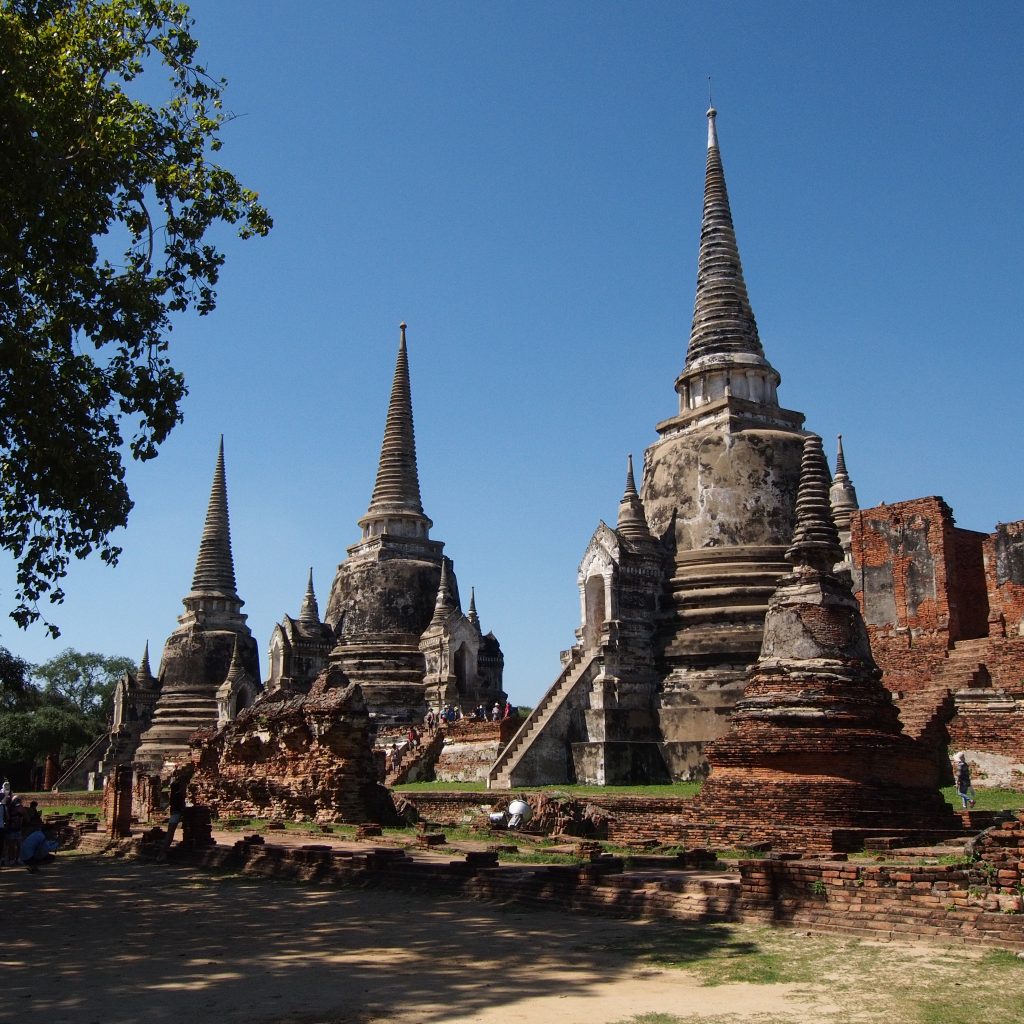

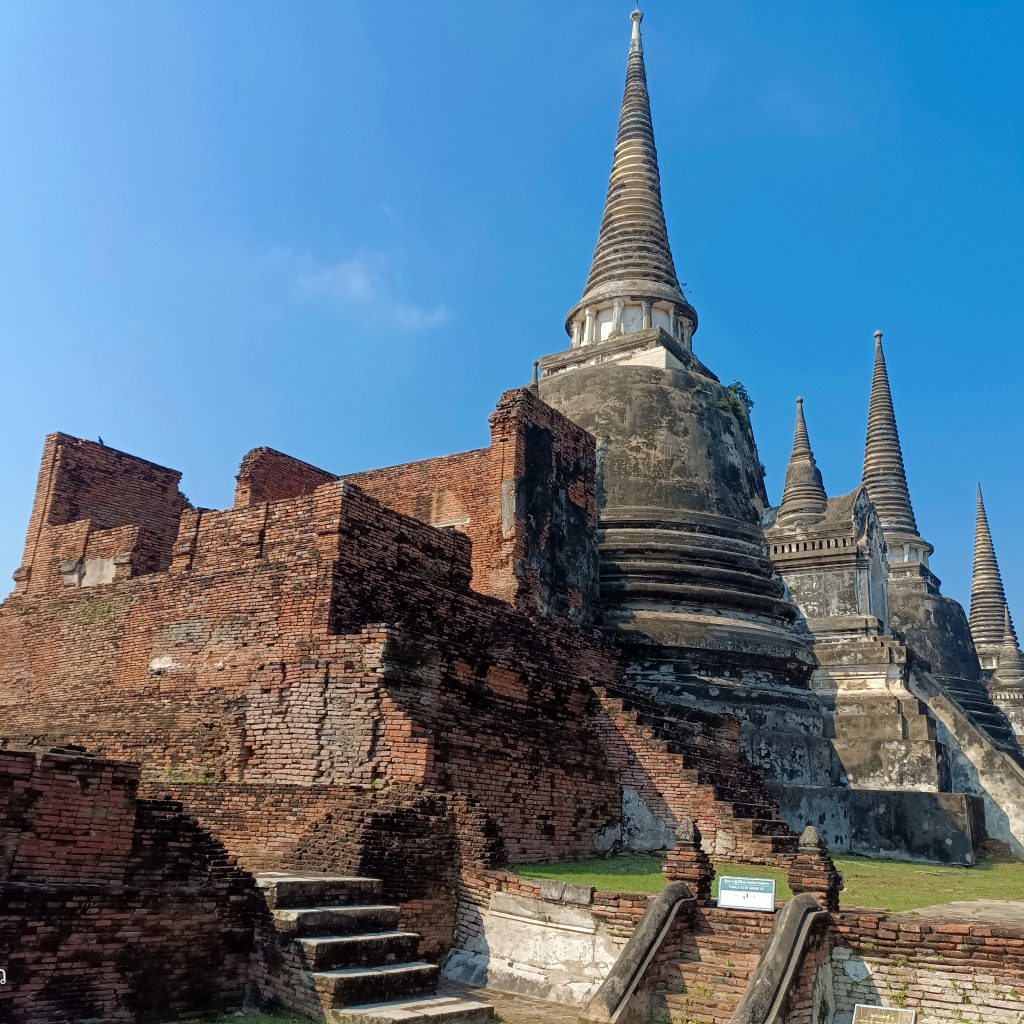
3. Vihan Mongkol Bophit
Phra Mongkhon Bophit is a bronze Buddha image in the attitude of subduing Mara; with a lap width of 9.55 meters and a height of 12.45 meters, it is one of the largest Buddha images in Thailand.
History
There is no clear evidence of when it was built. It is assumed that it was built in the early Ayutthaya period during B.E. 1991-2145 when King Songtham ordered to move it from the east outside the palace to the west side which is its current location. Also, he ordered to build of a Mandapa on top of it during the reign of King Suea. In B.E. 2249, a thunderbolt struck the top of the Mandapa, and Phra Mongkhon Bophitcaught fire and damaged the upper part of the Phra Mongkhon Bophit. Therefore, it was ordered to be renovated; converted the roof of the Mondop was into a cathedral and reinforced the head of Phra Mongkhon Bophit. During the reign of King Borom Kot (B.E.1742-1743) in the 2nd loss of Ayutthaya in B.E2310, Viharn Phra Mongkhon Bophit was burned by enemies and damaged the bun, and the right arm of Phra Mongkhon Bophit is broken. Later, King Rama 5 ordered it to be renovated accordingly. The area beside Wihan Phra Mongkhon Bophit on the east side, it was originally Sanam Luang; it was used as a place to build the royal crematorium for kings and royalty as well as the Sanam Luang of Bangkok. Wihan Phra Mongkhon Bophit was rebuilt on the remains of the original temple. Nowadays, it is a tourist attraction in Phra Nakhon Si Ayutthaya Province, as they always say “Anyone who has come to Ayutthaya but hasn’t come to pay respect to Luang Pho Mongkhon Bophit, is deemed as not arriving in Ayutthaya at all” There is a large souvenir shop in Ayutthaya in the area of Viharn Phra Mongkhon Bophit. Luang Pho Mongkolbophit: It is a sacred Buddha image of Phra Nakhon Si Ayutthaya. Currently, there are many local people and tourists who go to pay homage every day. It is also of interest to all foreign tourists in terms of the beauty and greatness of Luang Por.
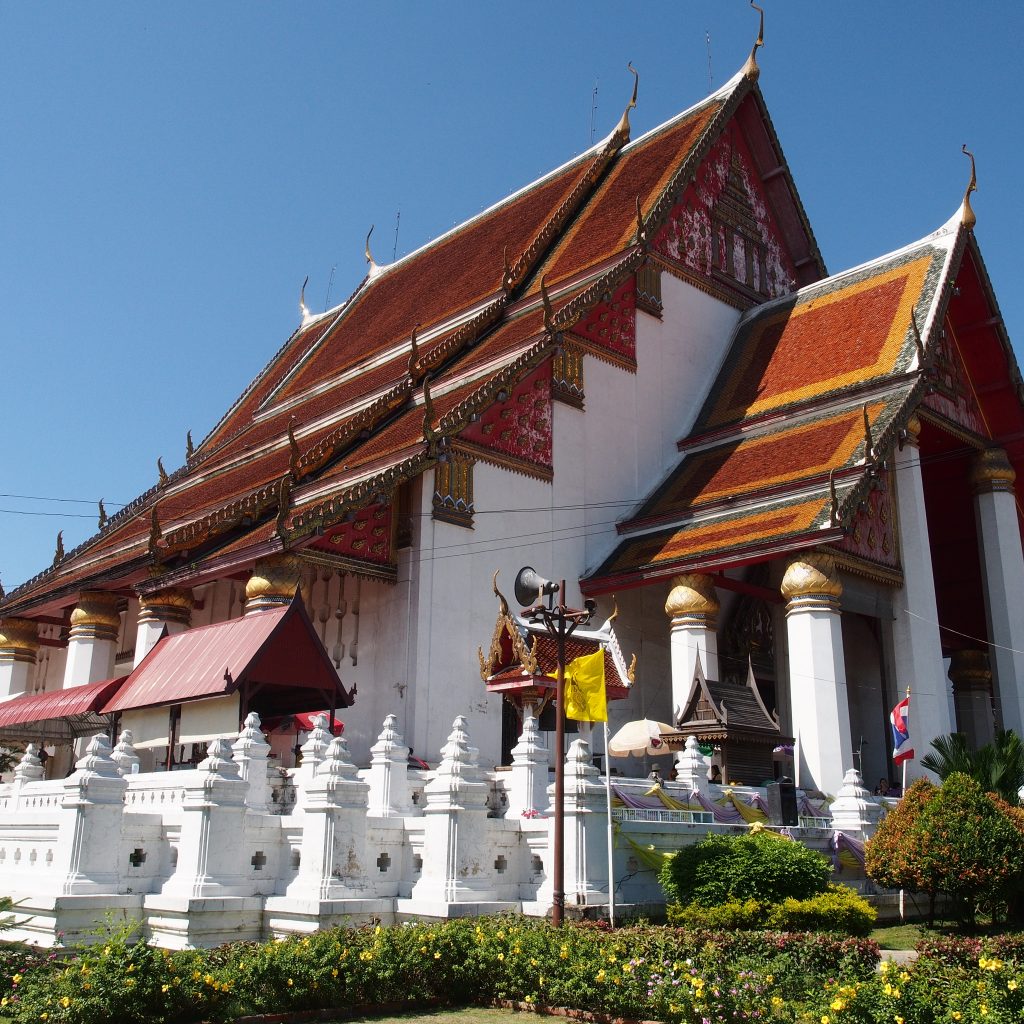

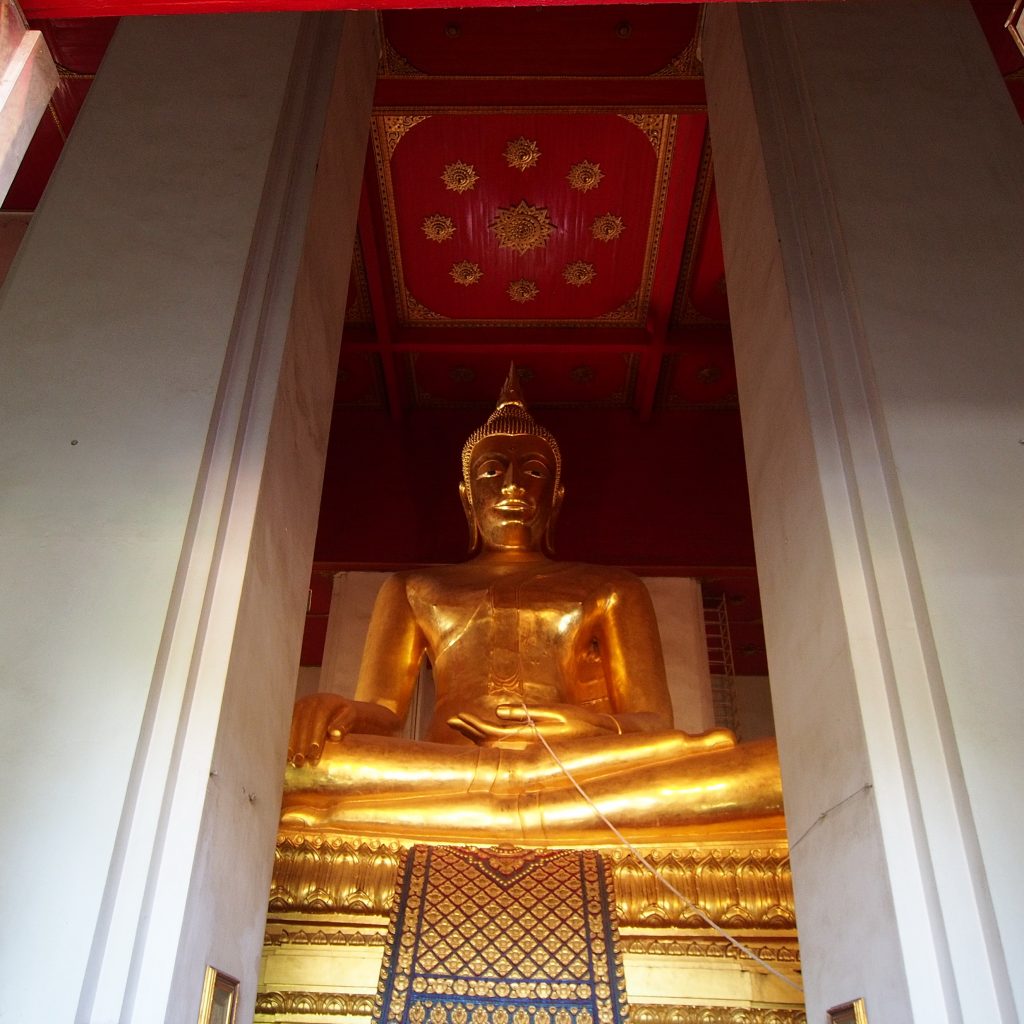
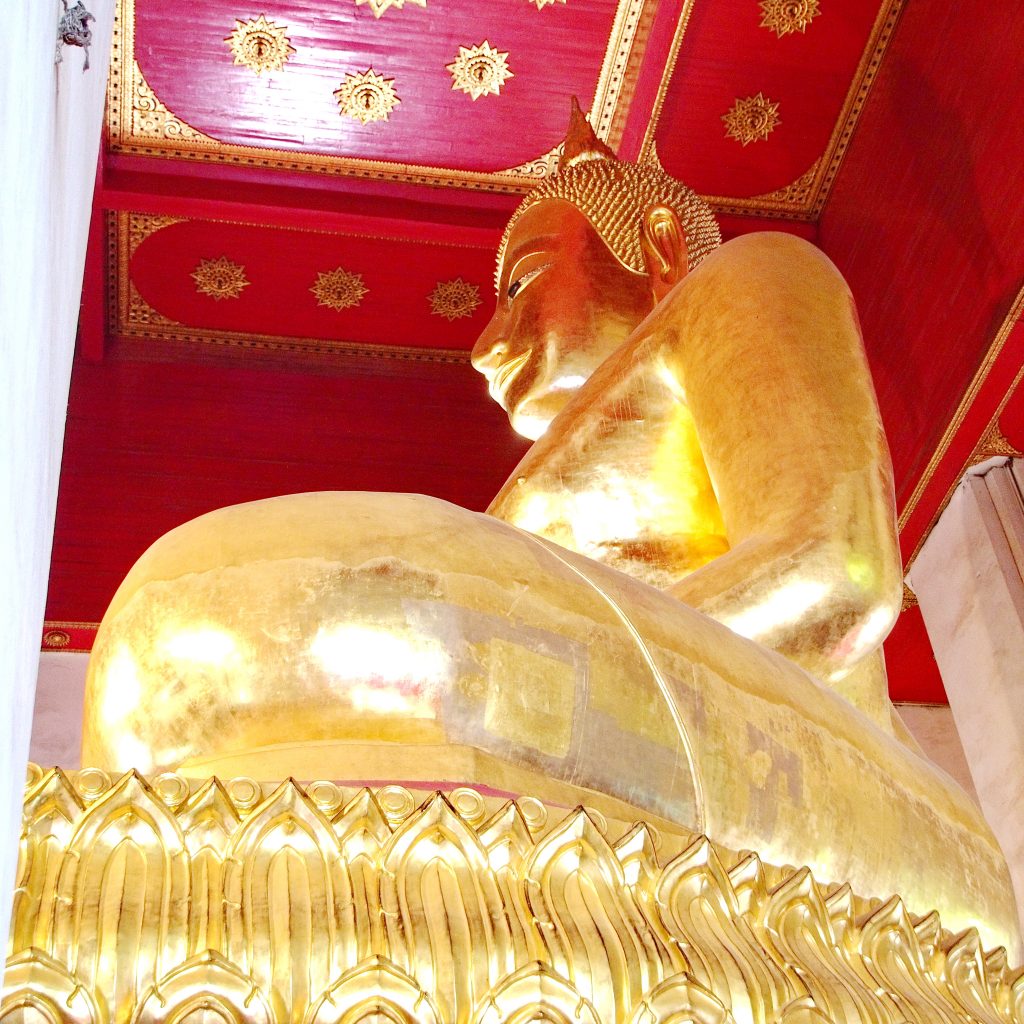
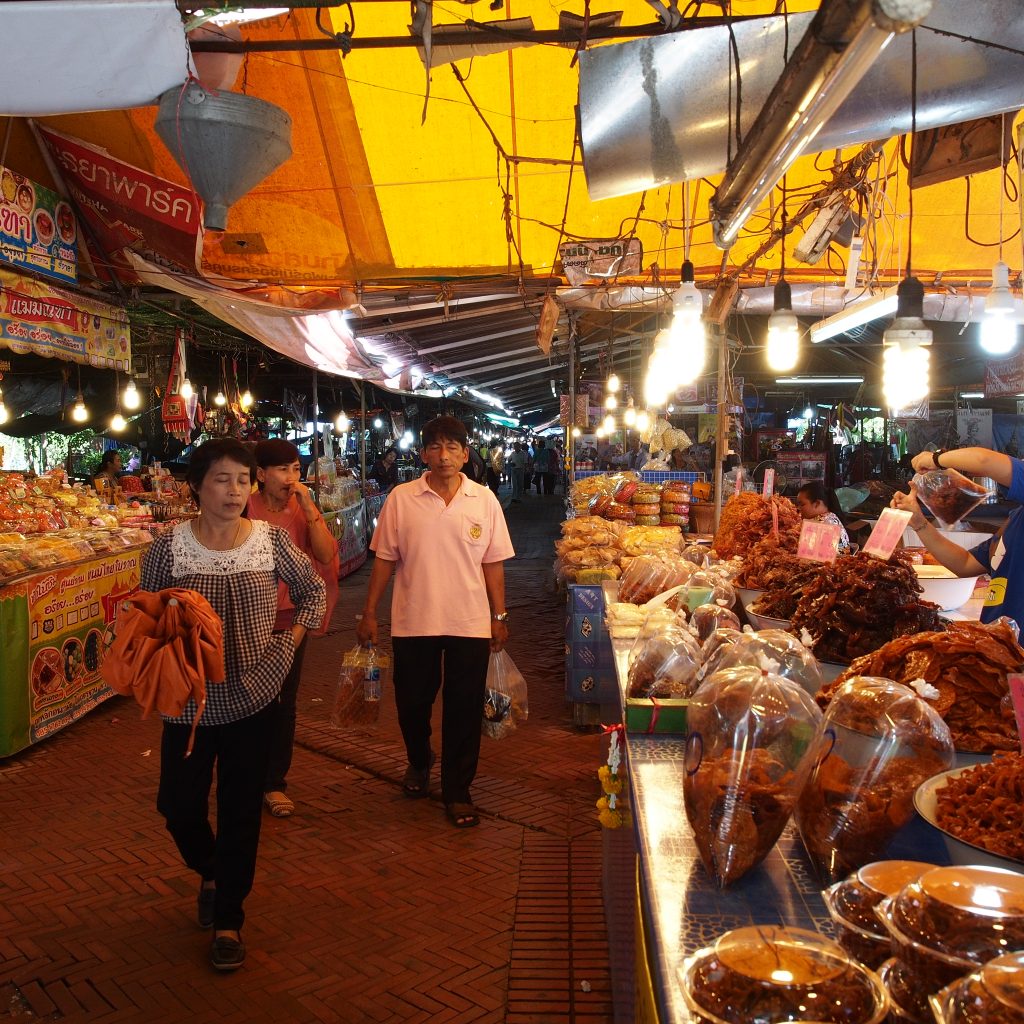
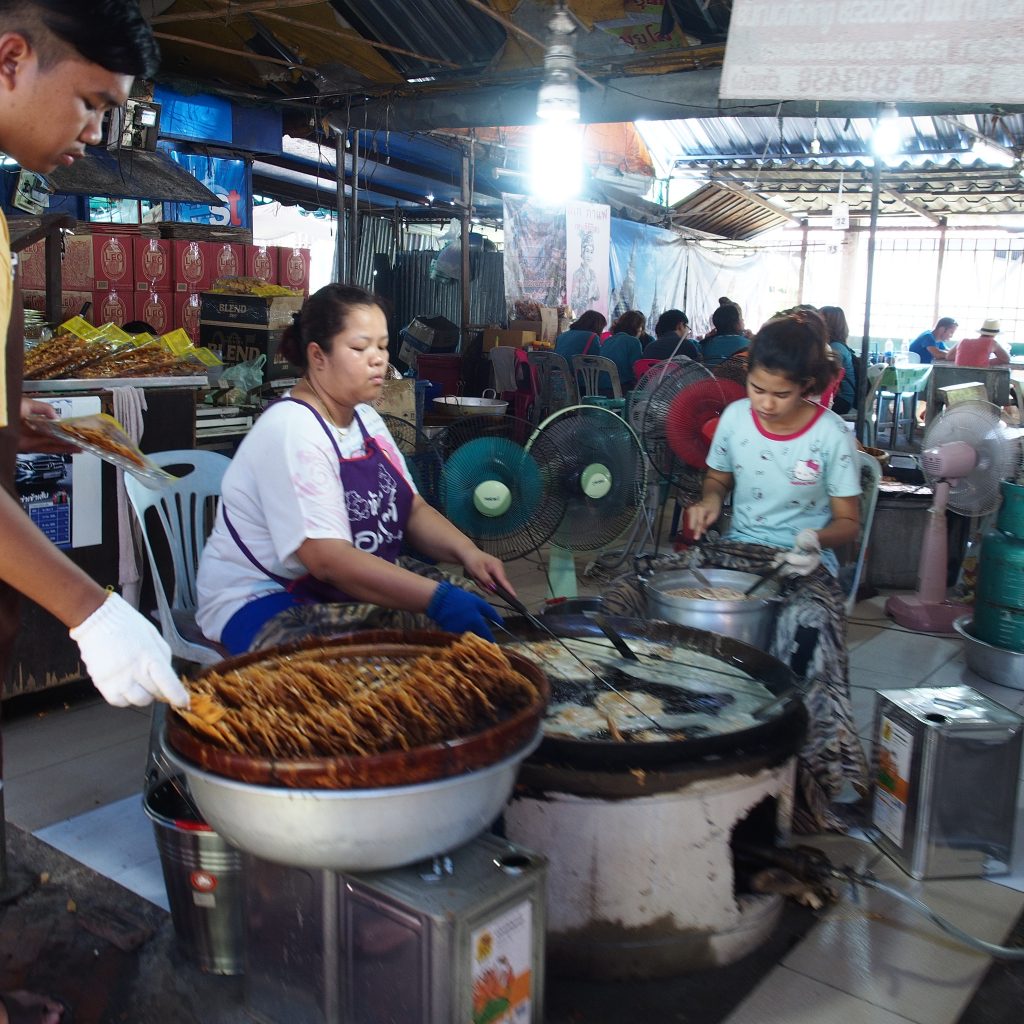
4. Wat Mahathat
Wat Mahathat is located in front of the Grand Palace to the east, next to Pa Than Bridge. The Temple is believed to be one of Ayutthaya’s oldest temples, possibly built by King Boromaraja I (1370-88).
Wat Phra Mahathat, Thailand, was a royal Temple of the Ayutthaya Kingdom. It is one of the oldest and most significant temples in the history of Ayutthaya as it housed the Buddha’s holy relic. Many important royal ceremonies of the Ayutthaya era had been hosted here. When the Ayutthaya Kingdom failed in 1767, Wat Phra Mahathat was severely damaged by fire and was since abandoned. The temple is located in the area of the Ayutthaya Historical Park nowadays. attractions in Wat Phra Mahathat of Phra Nakhon Si Ayutthaya include remains of important old buildings such as pagodas, octagonal pagodas, royal hall, small temples, murals under a Bodhi tree, and the famous sand-stone Ayutthaya-style head of the Buddha image in a tree’s root. Nearby attractions – The Ancient Palace, with only the basement of the building left to be seen today. – Wat Phra Sri Sanphet, an important temple in the royal palace of the Ayutthaya era. – Wat Ratchaburana, which stands opposite to Wat Phra Mahathat and is famous for its elaborately decorated main pagoda. – Wat Phra Ram, which was built in the reign of King Ramesuan in the area where his father, King Ramathibodi I, was cremated. – Vihara Phra Mongkhon Bo Phit, which was named after Phra Mongkhon Bophit, the sitting Buddha image with the gesture of Subduing Mara.
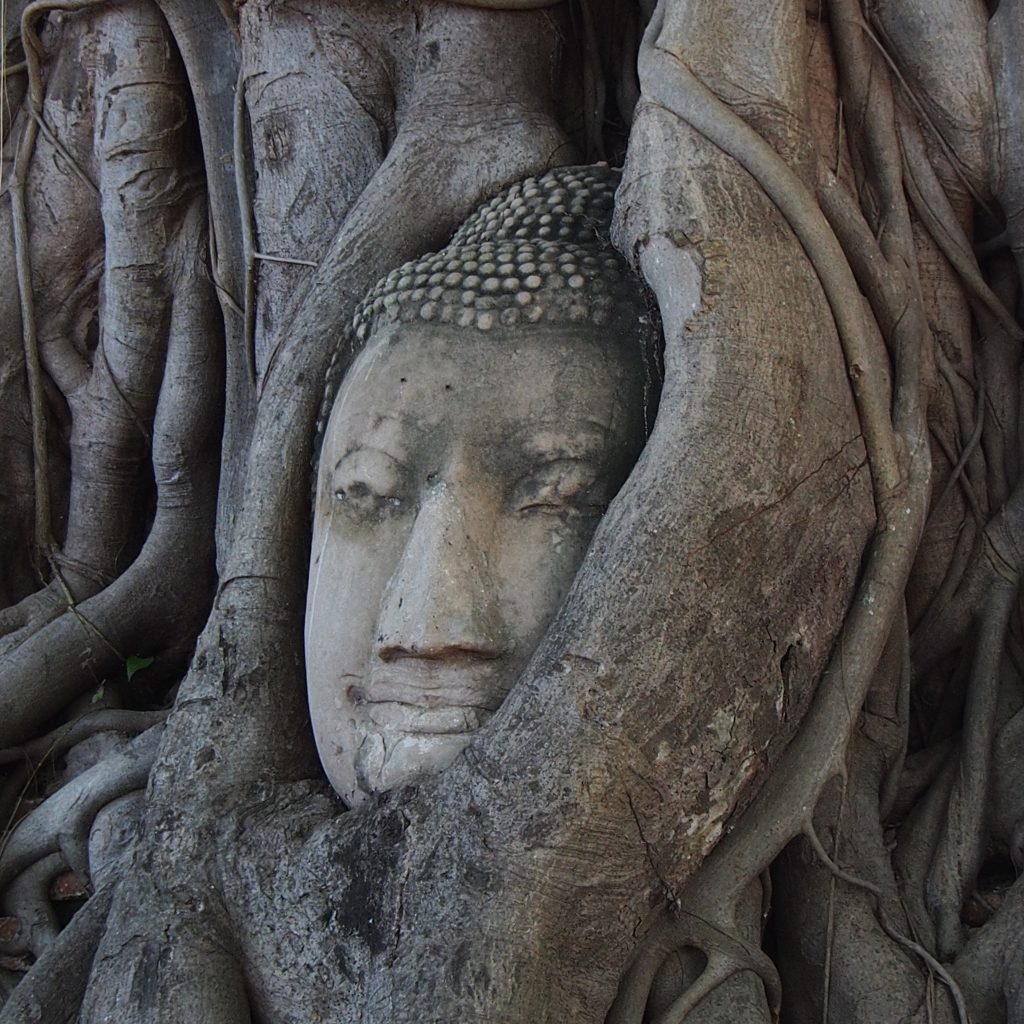
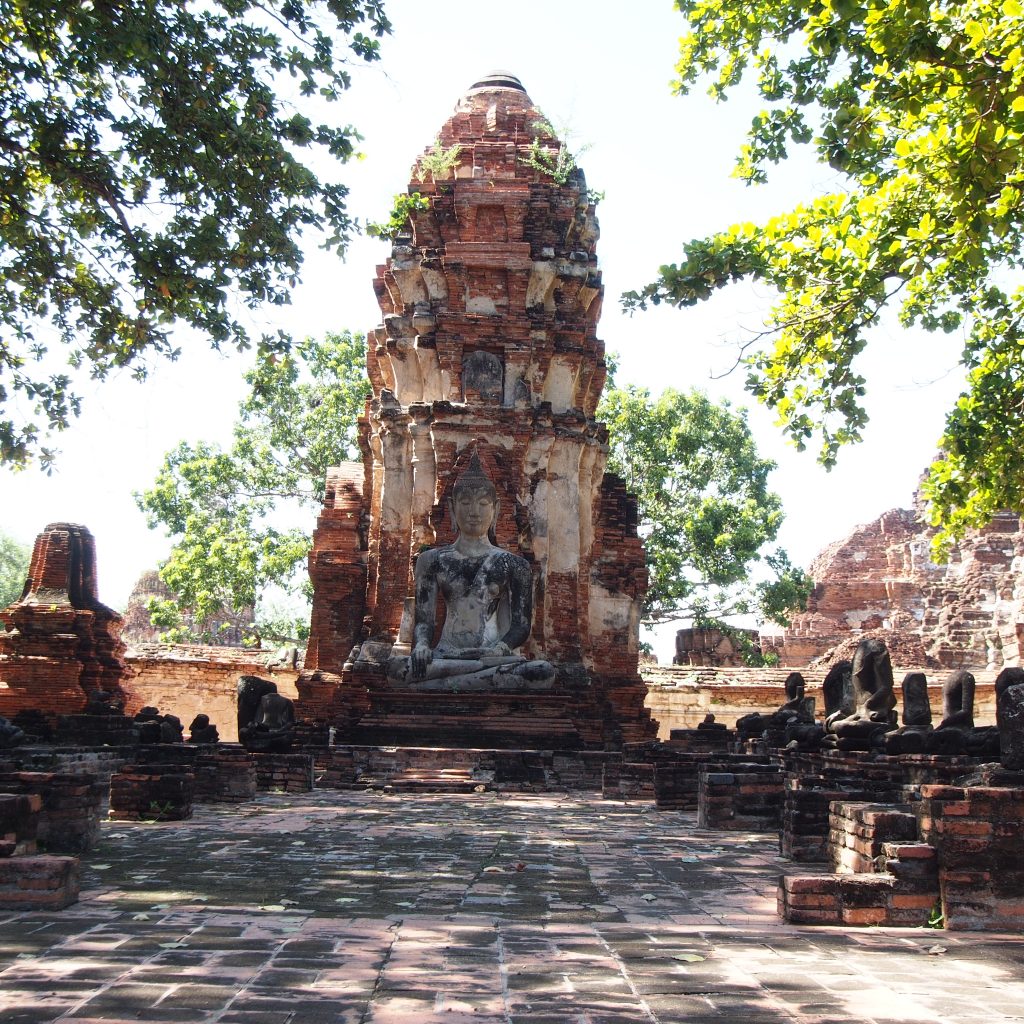
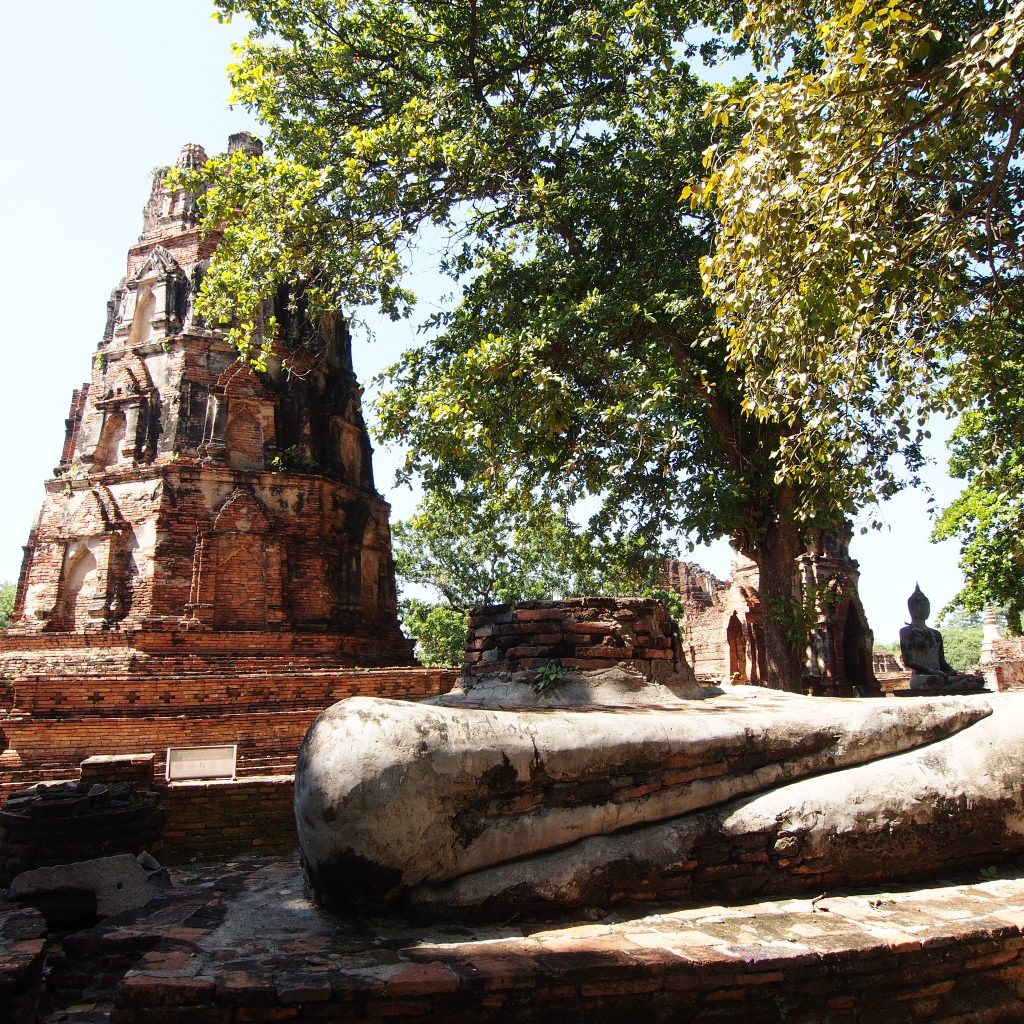
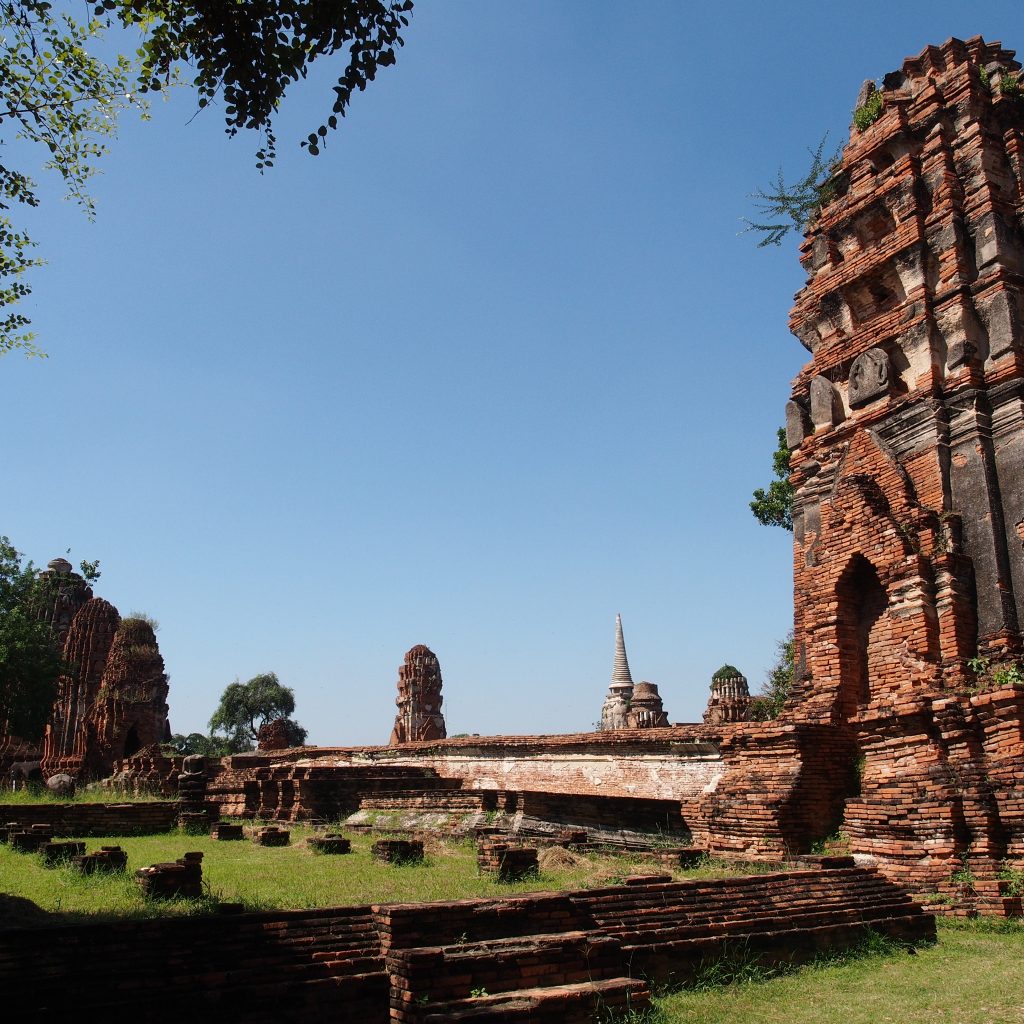
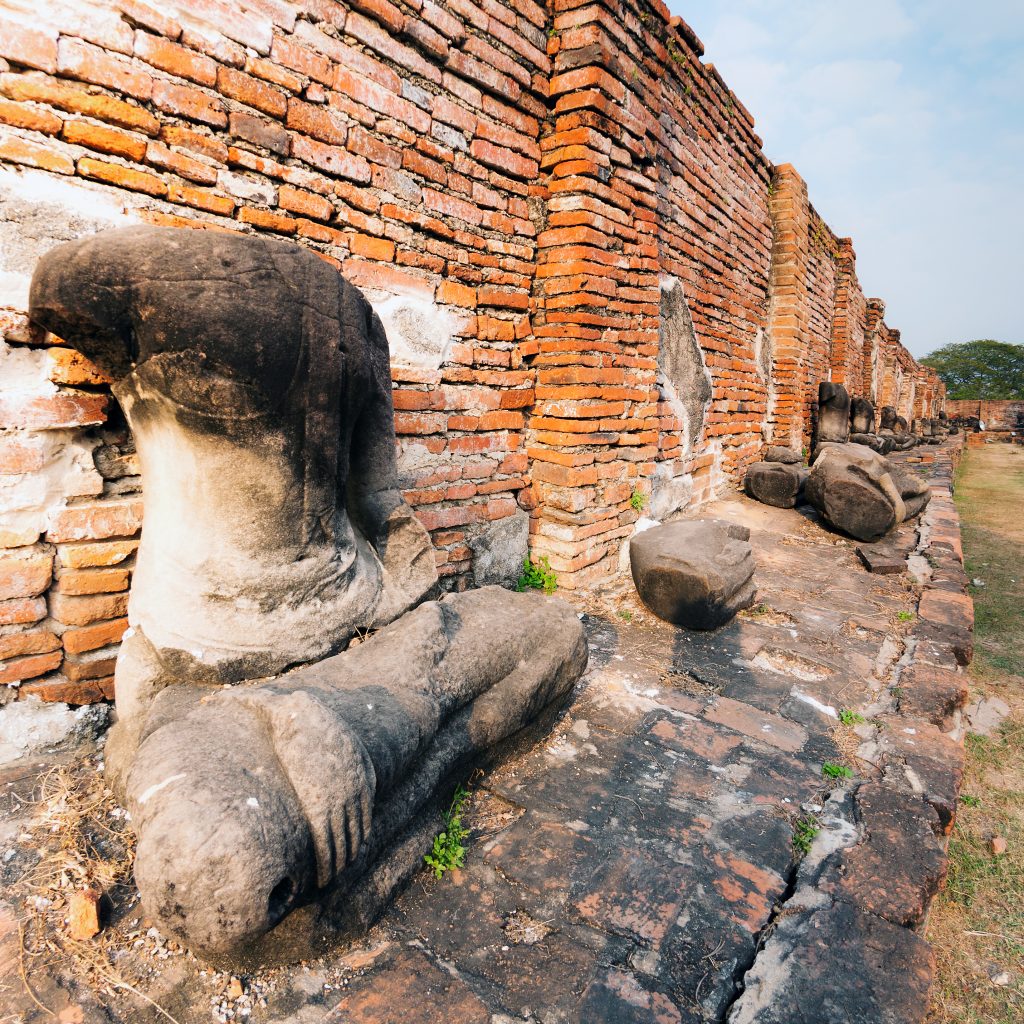
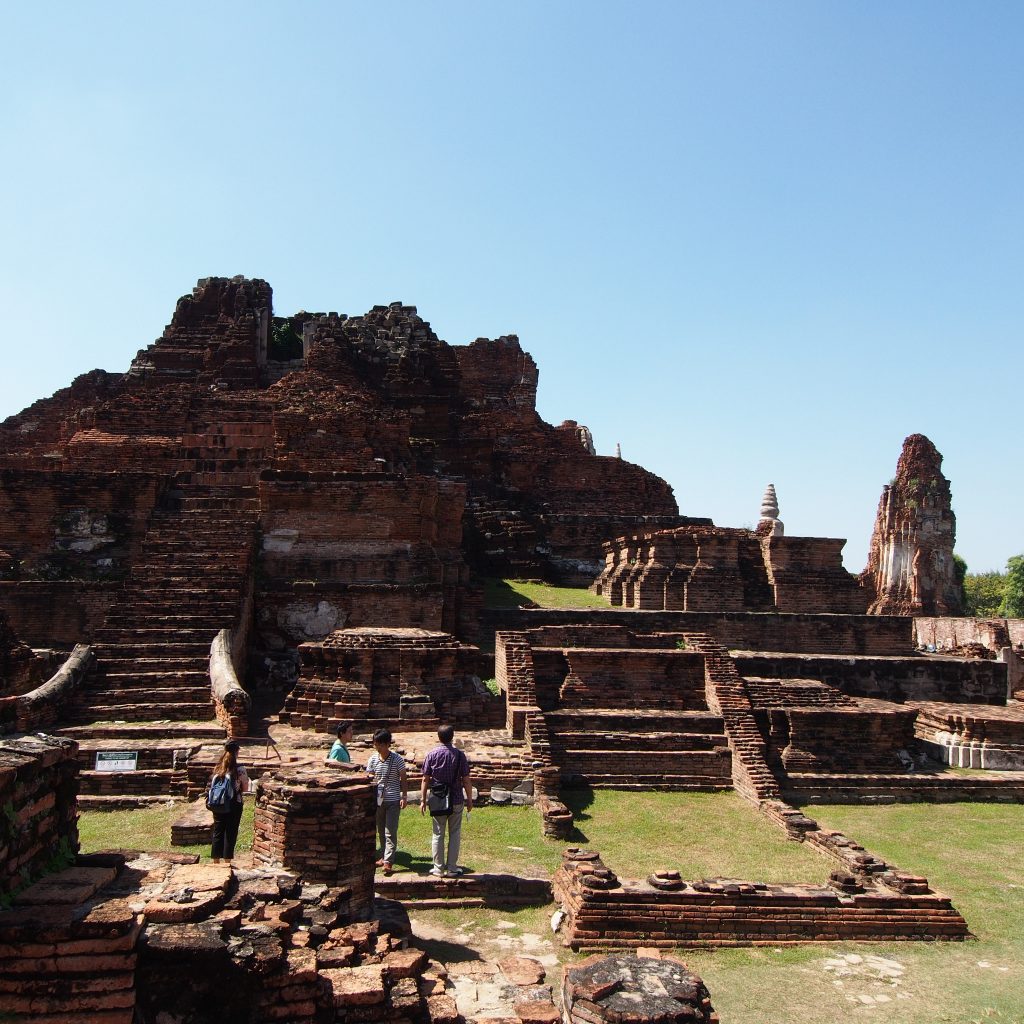
5. Wat Lokaya Sutha
Wat Lokayasutaram is located at Tambol Pratuchai, Amphur Pranakornsriayuttaya, Pranakornsriayuttaya. The location is near the Royal Palace and Wat Prasrisanpetch which are both the centers of the Ayuttaya Kingdom. Therefore, this is another important temple in Ayutthaya. This temple has another name called Wat Pra Norn. Inside the temple, there is the biggest reclining Buddha in Ayutthaya. This temple was mentioned in history as one of King Barommakote’s traveling routes. The reclining Buddha is a big white Buddha with a length of 42 meters and a height of 8 meters. Even though it is very old, it is still in perfect condition with a glowing face beaming with happiness and the head is supported by a lotus base platform. This reclining Buddha is an attraction for tourists both domestically and internationally. Moreover, there are also the ancient remains of a big building and the peristyle with the stupa at the height of 30 meters as the main stupa of the temple. Therefore, this temple is suitable for history lovers. The reclining Buddha is one of the heritages left from the war and also the pride of the Ayuttaya people.
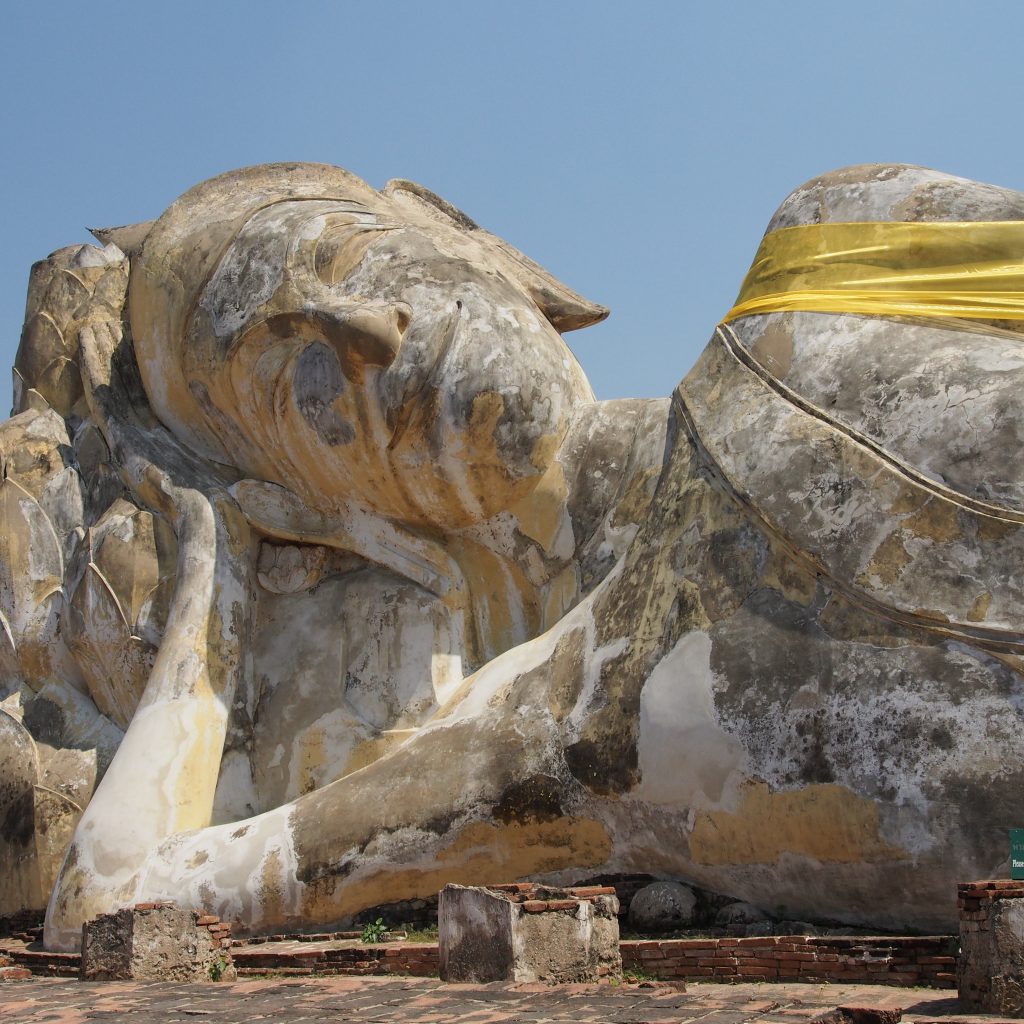
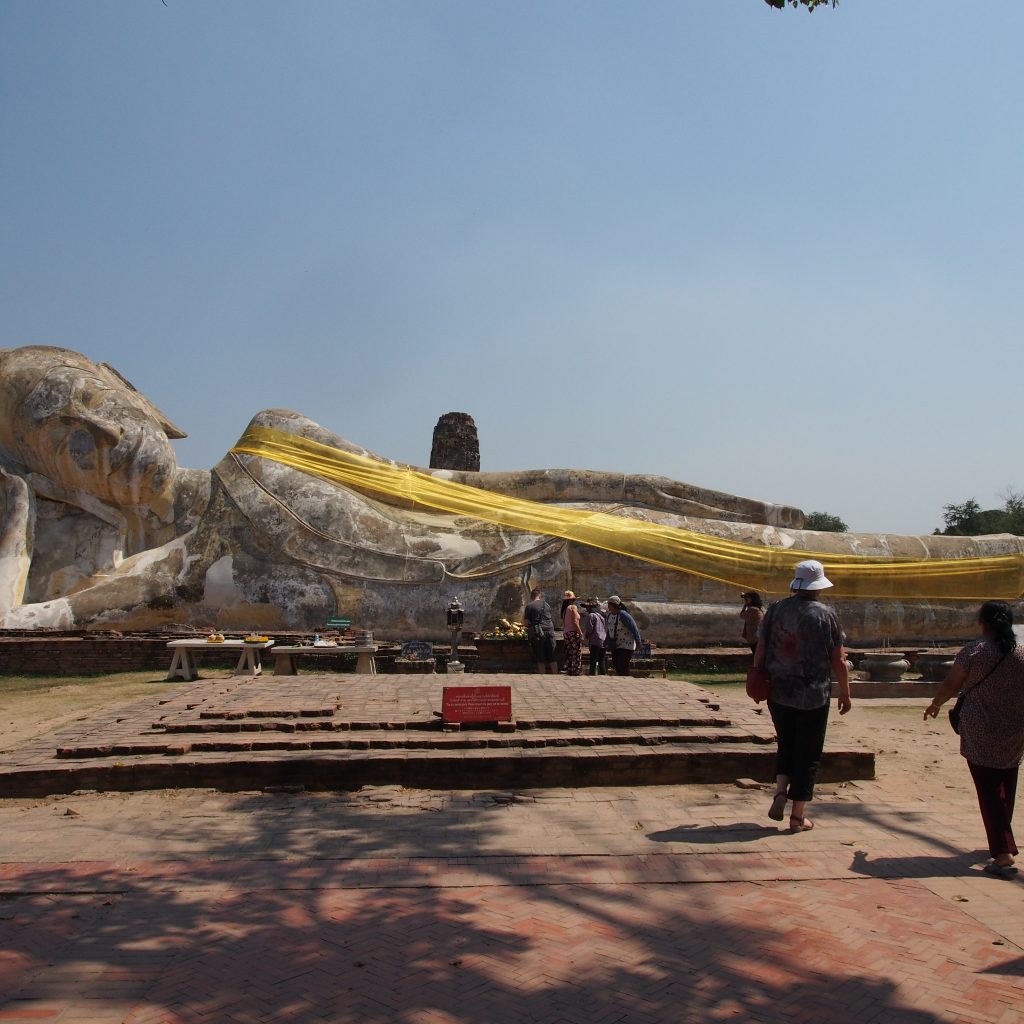
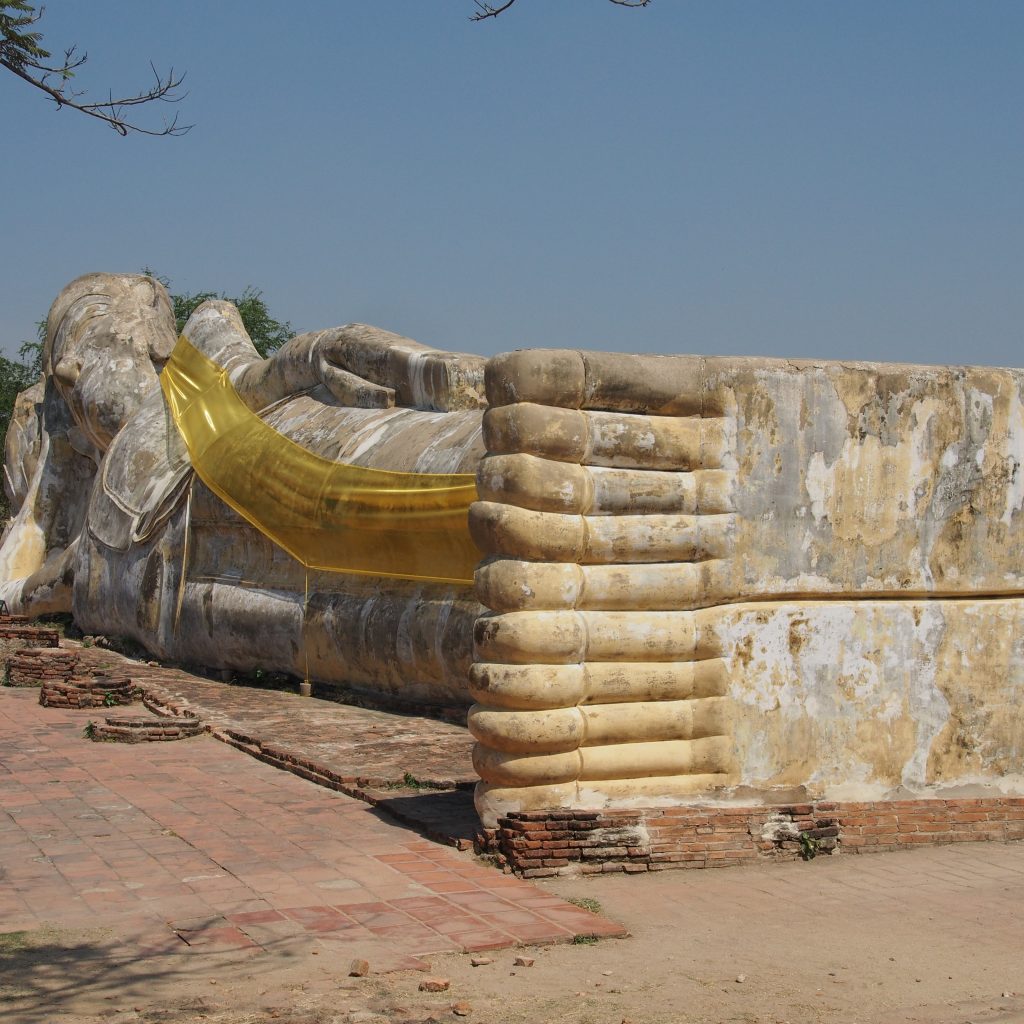
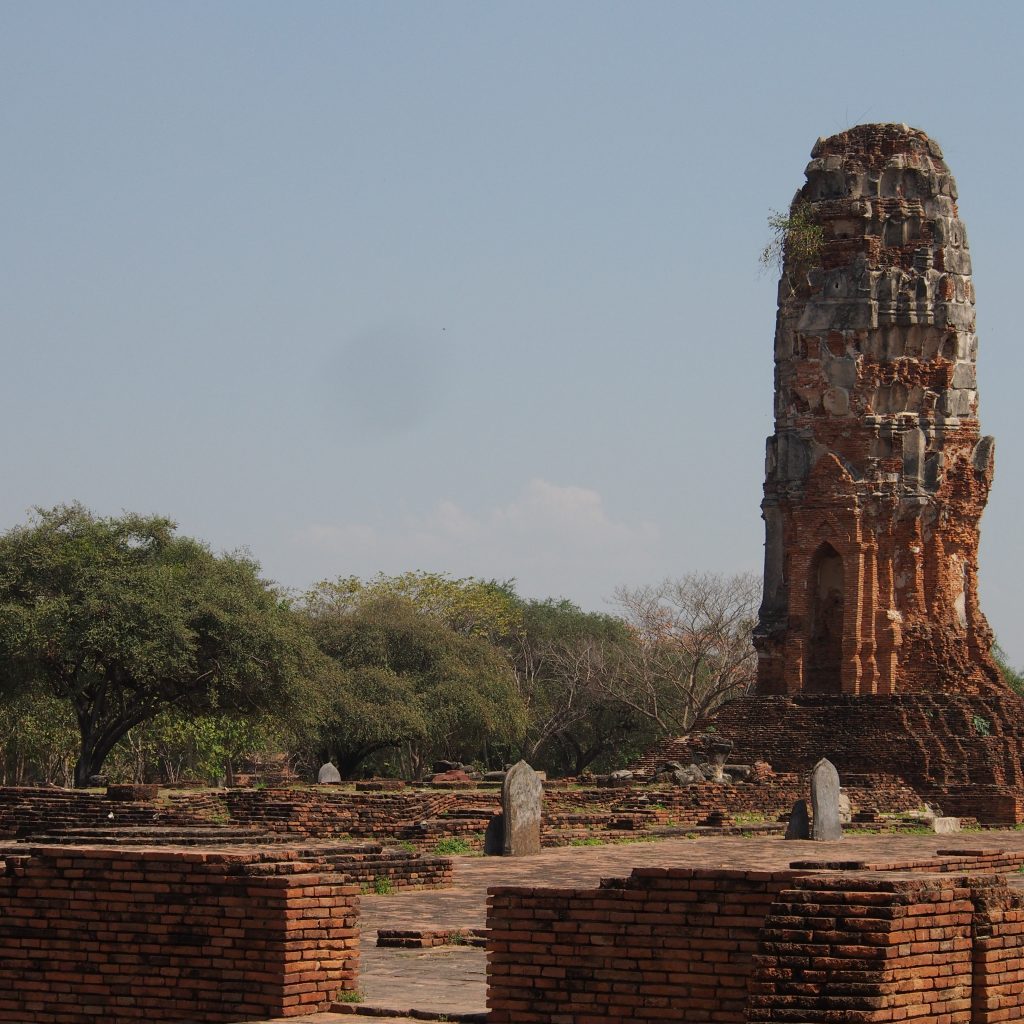
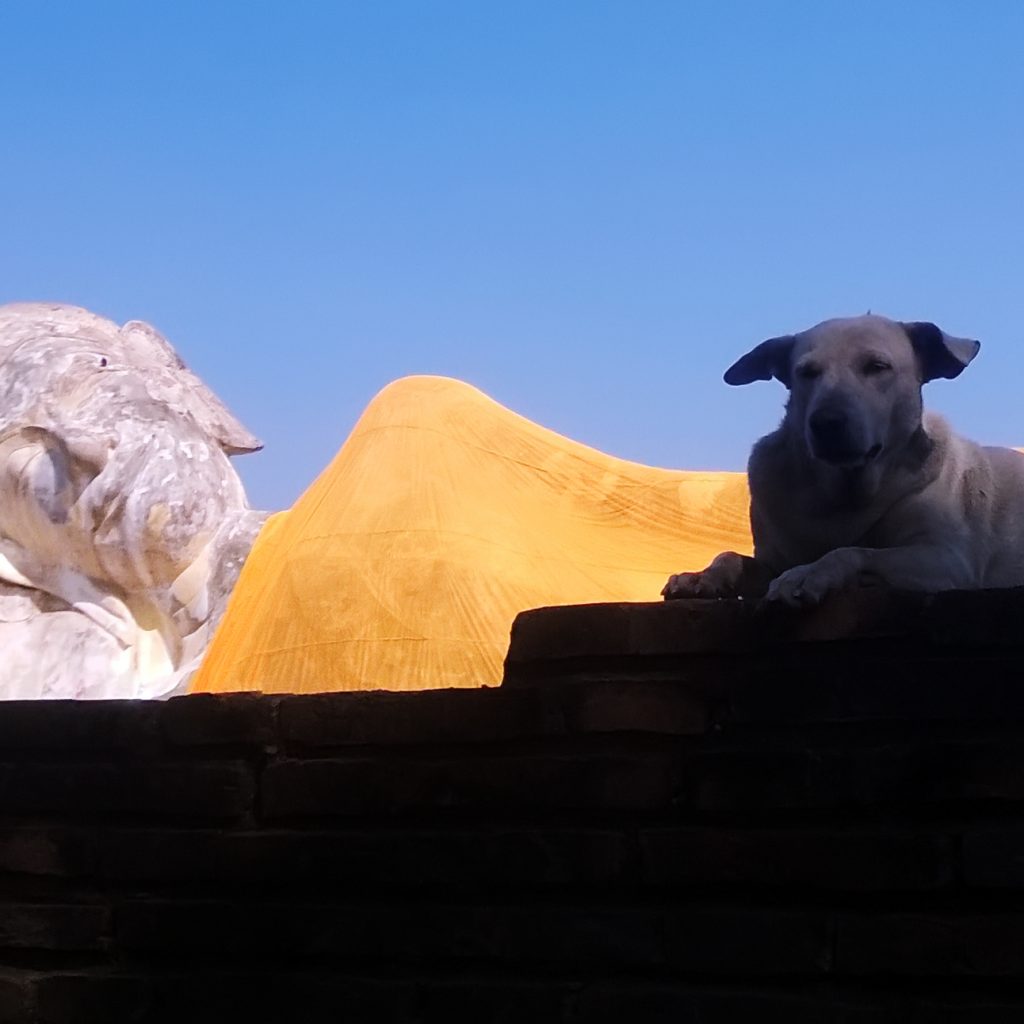
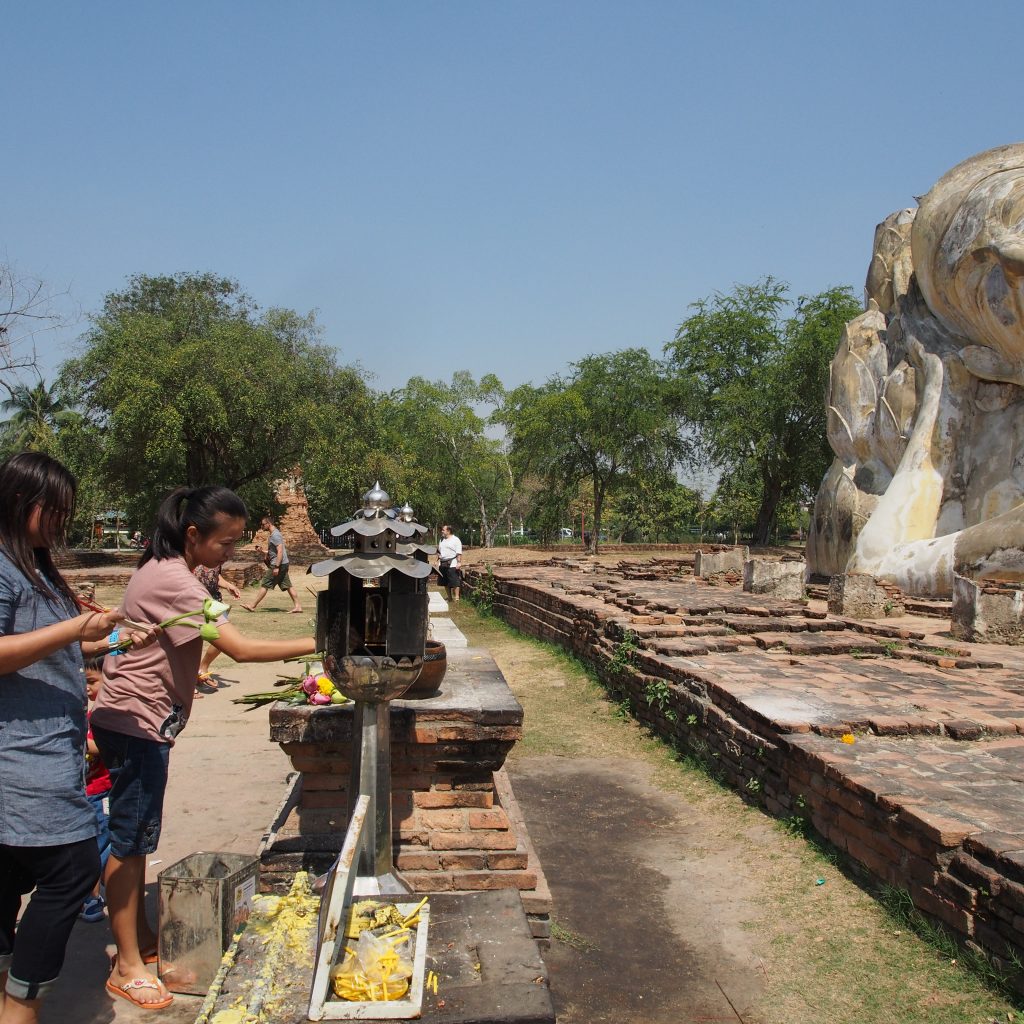
6. Wat Yai Chaimongkol
Wat Yai Chai Mongkol on the east of Ayutthaya is outstanding with a huge bell-shaped pagoda on an elevated square base surrounded by four smaller pagodas at the corners and a gigantic reclining Buddha statue at the entrance. The Temple was built in 1357 for monks ordained and trained at the Monastery of Phra Wanaratanathen in Sri Lanka.
History
The monastery was constructed by King U-Thong in 1357 AD to accommodate the monks that Phra Wanratana Mahathera Burean ordained. This monastery was named “Wat Pakaew”.
Afterward, Phra Wanratana of Wat Pa Kaew suggested to King Naresuan the Great to build a Chedi (pagoda). He decided to construct a large Chedi in this monastery in 1592 AD. This monastery became known as Wat Yai Chaimongkhon.
Wihan Phraphutthasaiyat
Wihan Phraphutthasaiyat (the name of the ordination hall) was constructed during the reign of King Naresuan the Great for religious adoration and royal meditation. The Buddha Image was restored in 2508 B.E (1965), according to a publication of the Wat.
Wat Yai Chai Mongkhon
The ubosot (buddhist temple) and vihara (monastery) have their rear sections extended through the gallery. The satellite stupas of varied structural forms and contemporary with the main stupa are lined up outside the gallery.
Phra Chedi Chaimongkhon
King Naresuan the Great had an order to construct this Chedi as the memorial for his victory over King Maha Uparacha of Burma.
The Ubosatha Hall
The Uposatha Hall is the main hall for the Sangha (Brotherhood of Monks). It is used to hold important religious ceremonies. It was first built by King U-thong who proclaimed this as the royal monastery of the forest order.
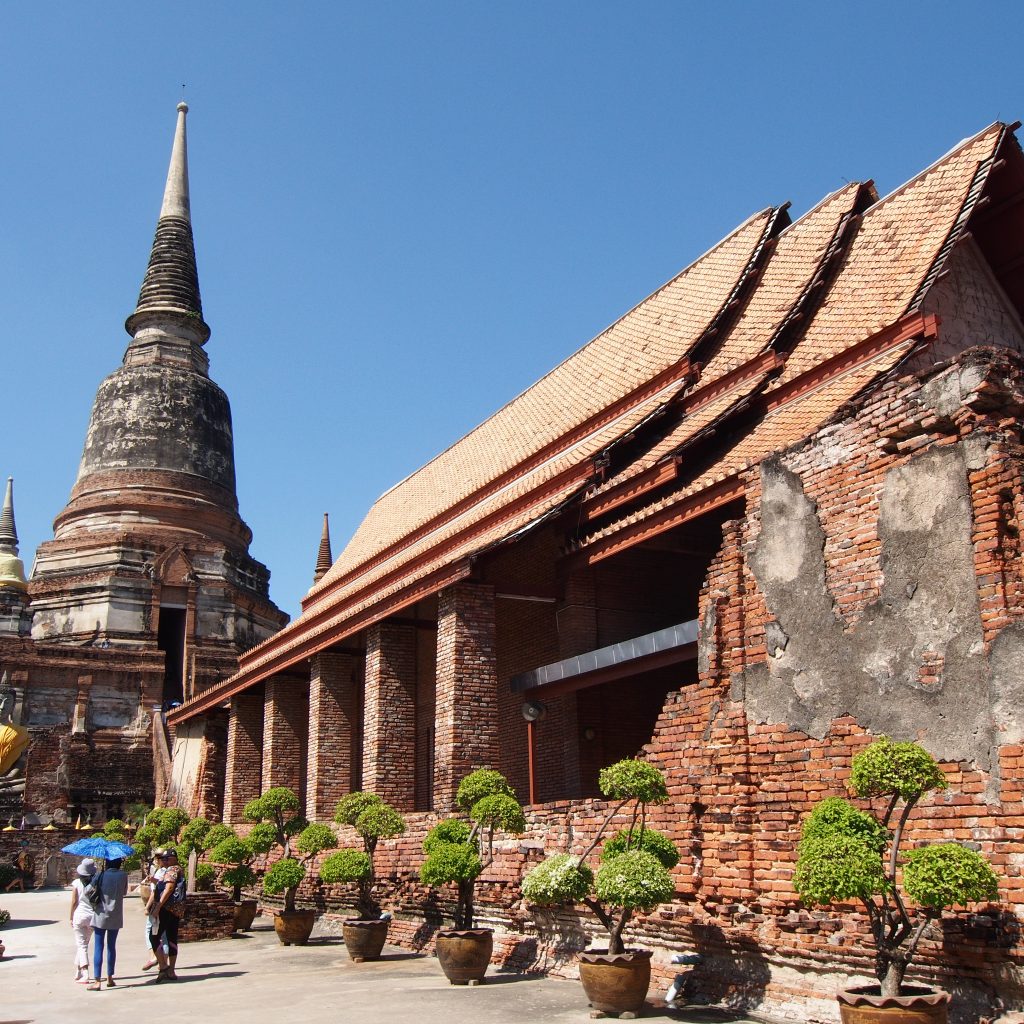
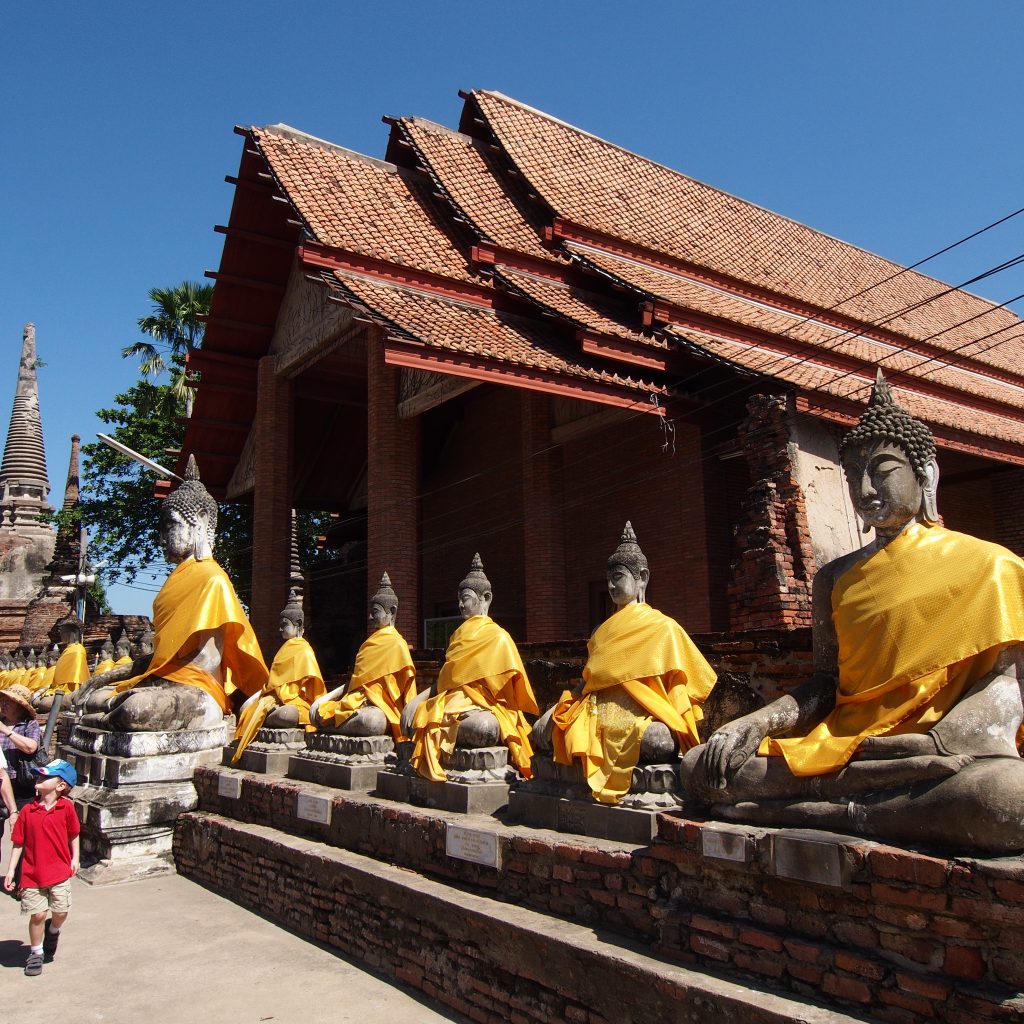
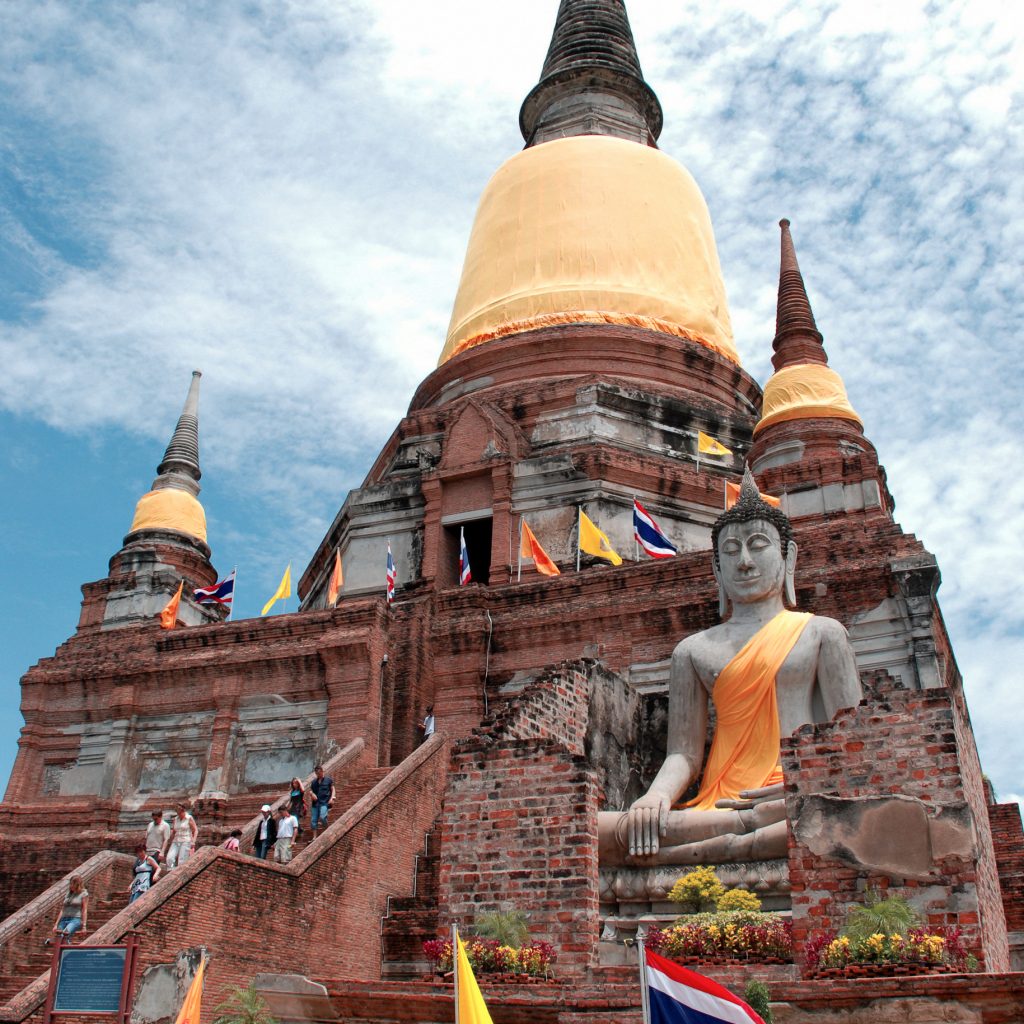
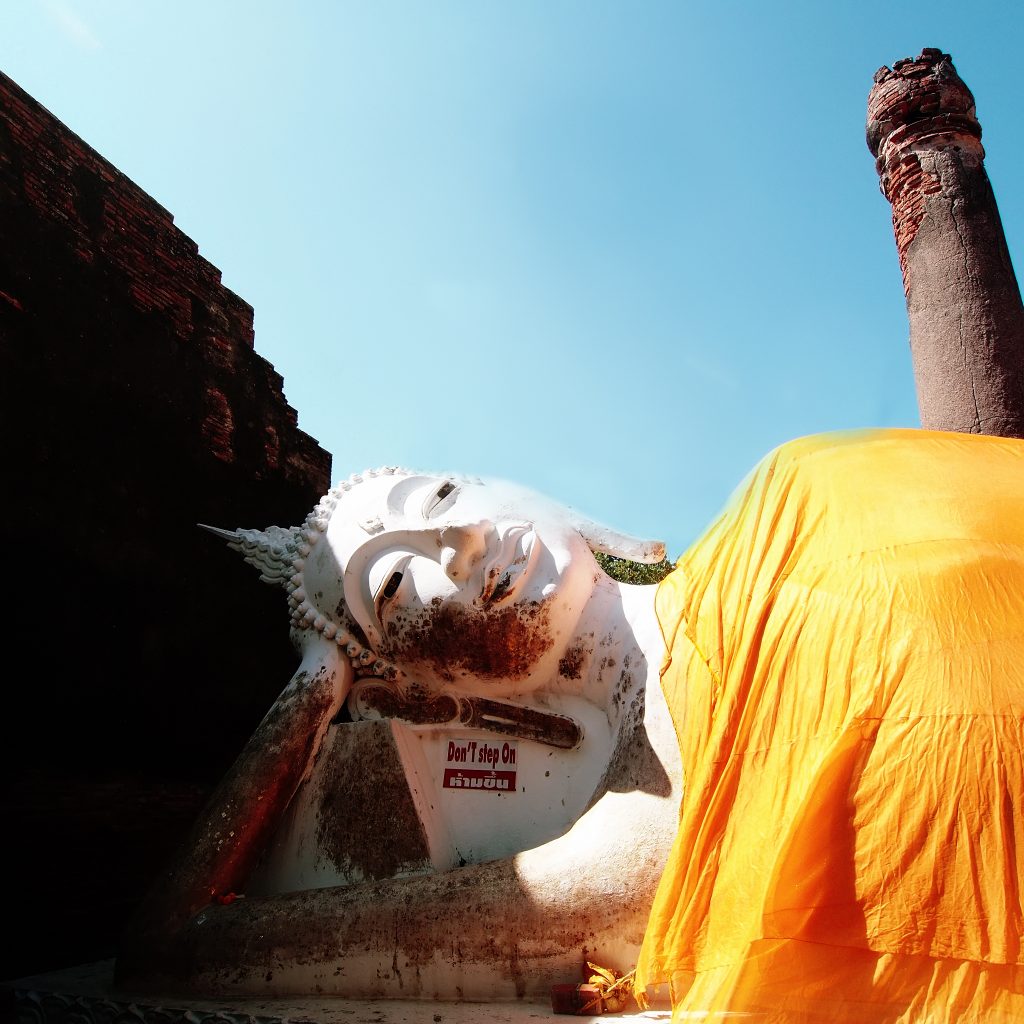
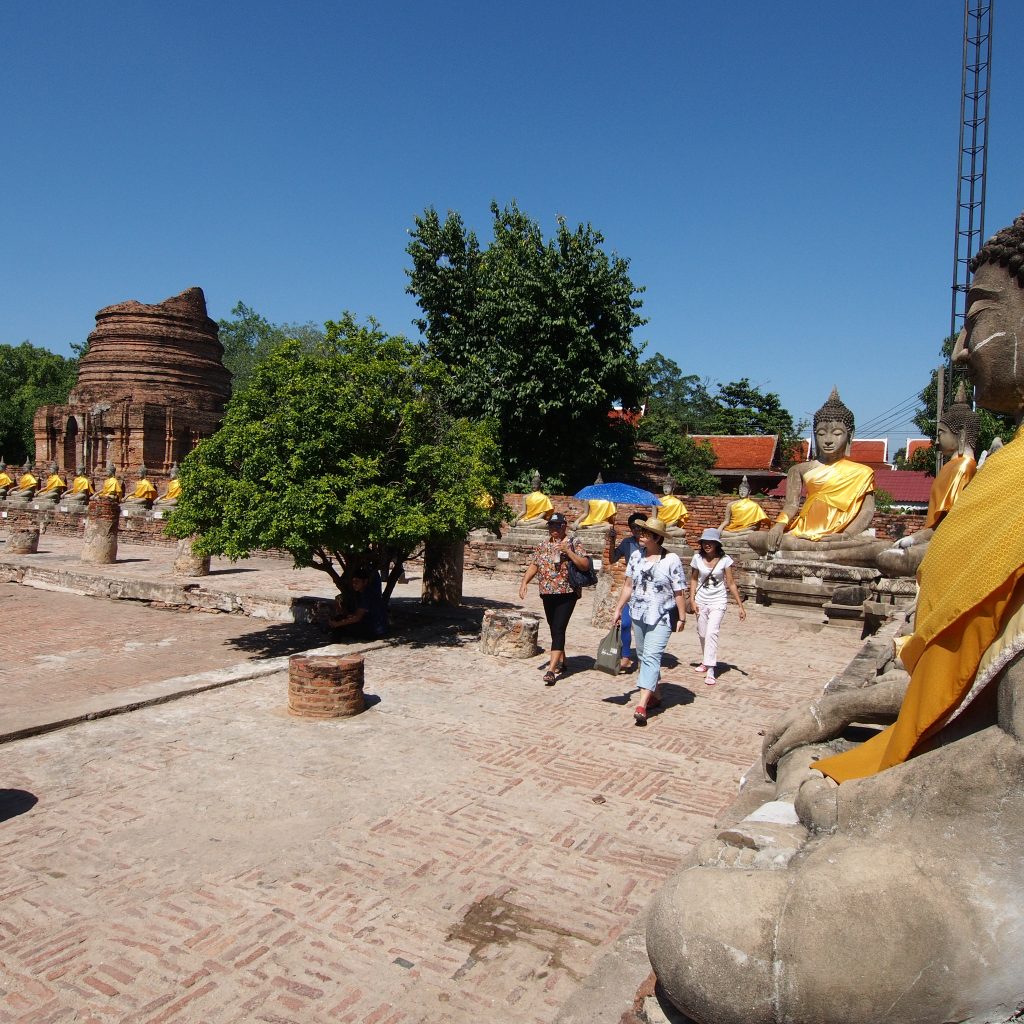
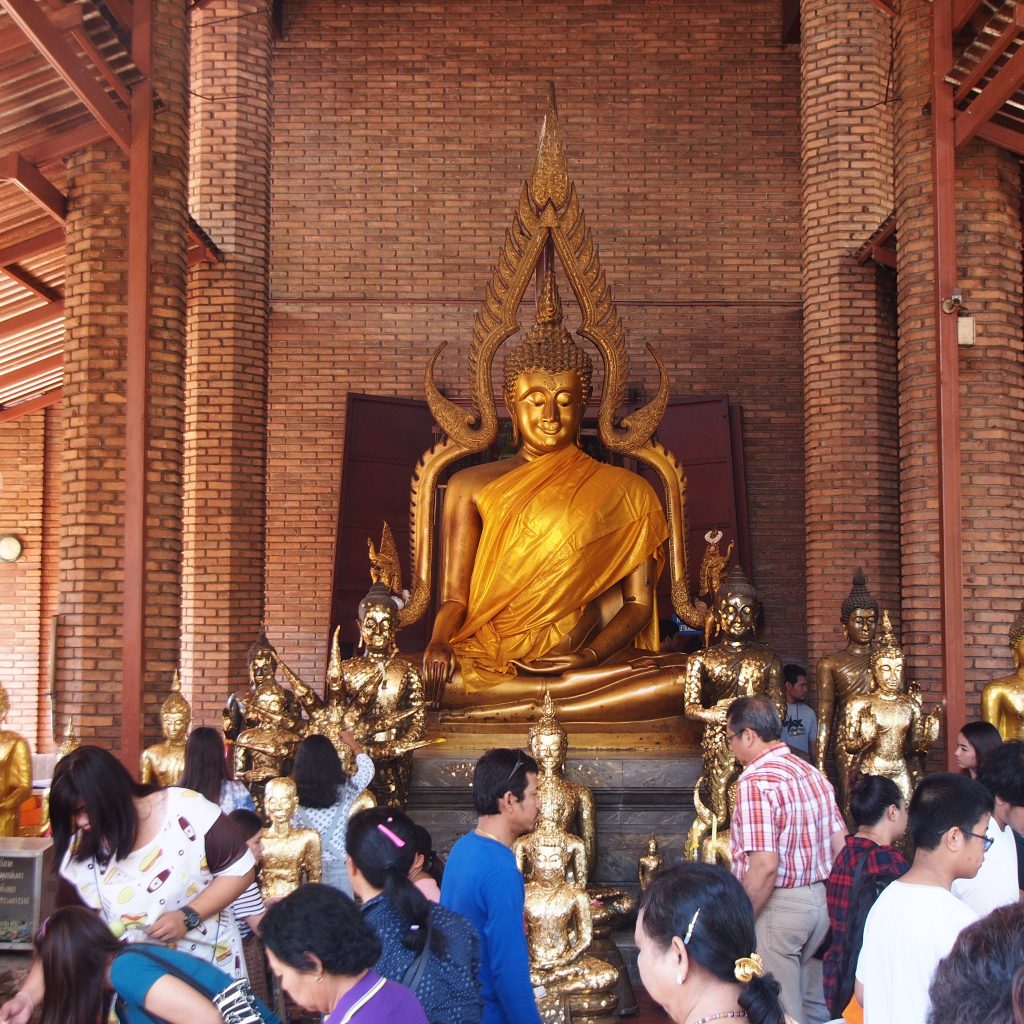
7. Bang Pa In
A few miles down the Maenam Chao Phraya from Ayutthaya is the Bang Pa-In Summer Palace. The site was first used by the royal court as a summer retreat in the 17th century. However, the Palace was destroyed with the fall of the Kingdom of Ayutthaya and was restored by King Rama IV in the mid-19th century. Most of the buildings that exist today date from the reign of King Rama V, who regularly spent his summers there. The structures represent a variety of architectural styles, set in a large park around ponds and waterways.
Bang Pa-In Palace is an ancient palace back in the Ayutthaya era. This palace was built by King Prasart Thong and then it was rebuilt by King Mongkut after it was abandoned for a long time. The palace is divided into 2 zones one is an inner zone that for the royal family to use as a resting place the other zone is an outer zone that is open for normal people and tourists. According to Bang Pa-in Travel Guide, there is a lot of place tourist can pay a visit to in this palace. Hem Montein Tewa Raja Tower (King Prasart Thong Shrine). This was built in Khmer style by King Mongkut in addition to honor King Prasart Thong the one who first built this palace. Aisawan Thiphya-Asana Royal Pavilion. This royal pavilion was built by King Mongkut in the middle of the palace’s basin. It is a copy of the Arporn Phimok Prasart royal pavilion in Bangkok and named follow by the first royal pavilion built by King Prasart Thong in the past. Vropas Phimarn Palace. This palace is a Greek Corinthian Order style palace. It was built for royal ceremonies or to welcome the royal guest. Aside from any ceremony this palace also has a storage of ancient weapons, carve statues,s and other tributes that gift to the royal family. Saphakan Ratchaprayun. This is the assembly hall built opposite Vropas Phimarn Palace in order for royal family followers to use it as an accommodation. Tewa Raja Kunlai Gate. This is a gate on top of the bridge that connects Bang Pa-In Palace’s inner and outer zone together. Uthayarn Phum Satein Palace. This is the wood palace built in the Swiss Chalet style. All around the palace is decorated by highly rare and valuable assets that tributes from across the country. Sadly the palace was accidentally burned in 1938 and the hold palace and its asset were turned to ashes. After the accident, King Bhumibol Adulyadej rebuilt this palace as a concrete palace. Vehas Jumrune Palace. This palace is a Chinese-style palace and it use as a winter palace. The palace was built by a local millionaire name Lord Shoduk and his nickname is Fuk. He built this palace in order to offer it to King Chulalongkorn. The palace has a name in the Chinese language it is Tien Meng Toei. The architecture and art style of this palace is truly a masterpiece there is carving art on every wall the main chamber floor is Jay tile with art paint on each tile also the surrounding area decorate with Chinese furniture and decoration. This palace sometime opens a room on the first floor for tourists to pay a visit. Bubpha Prapas Royal Pavilion. This pavilion was built by King Chulalongkorn in the garden next to Vehas Jumrune Palace in order to be a place to relax and take a look at the flower garden. Vitule Tassana Tower. This tower was built by King Chulalongkorn alongside the Bubpha Prapas royal pavilion in order to be a view tower for taking a look at all areas. Queen Sunanta Kumarirat Monument. This is a monument built by King Chulalongkorn to be a memorial of his beloved consort who pass away in a boat accident. Raja Nusorn Monument. This monument was built along with Queen Sunanta Kumarirat Monument in order to be a memorial for another royal family member that passed away in the same boat accident as Queen Sunanta Kumarirat. There are quite a lot of ways to travel to Bang Pa-In Palace tourists can choose the most suit way for themselves.

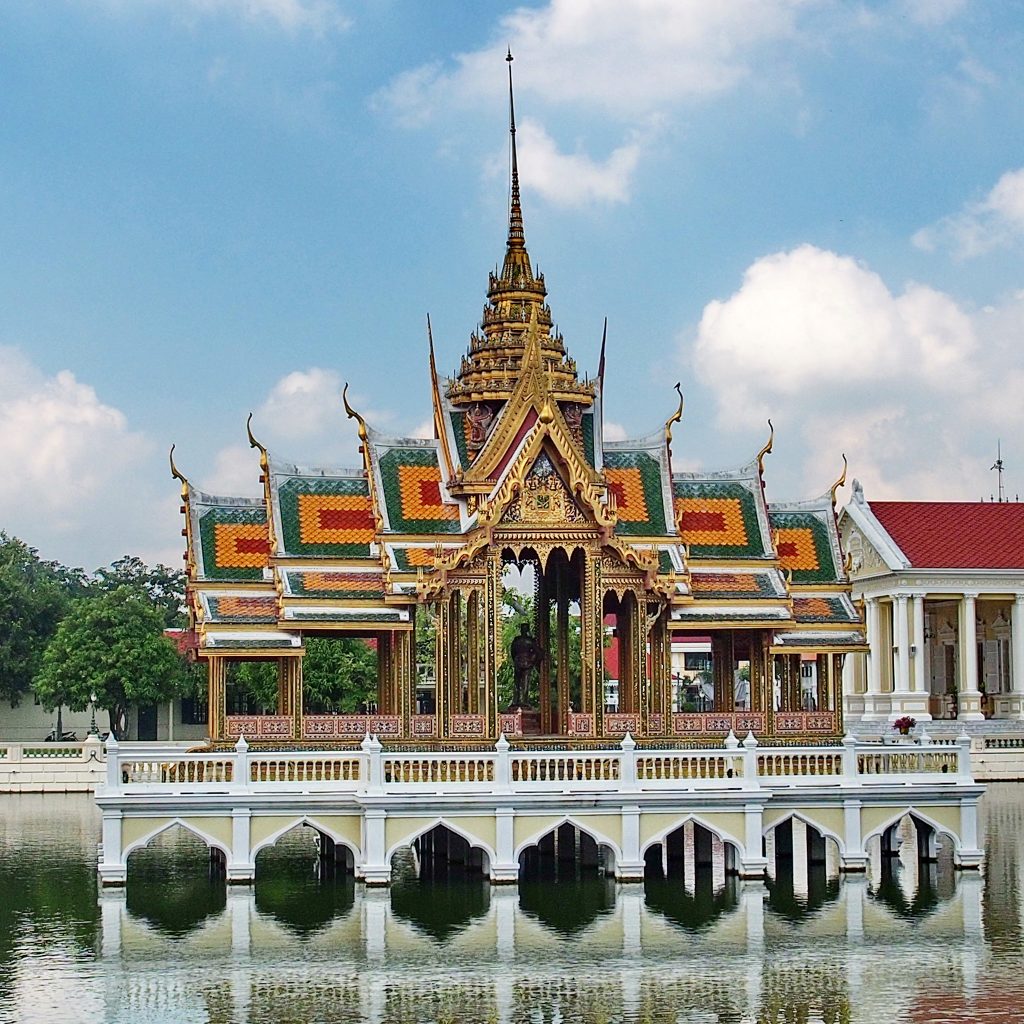
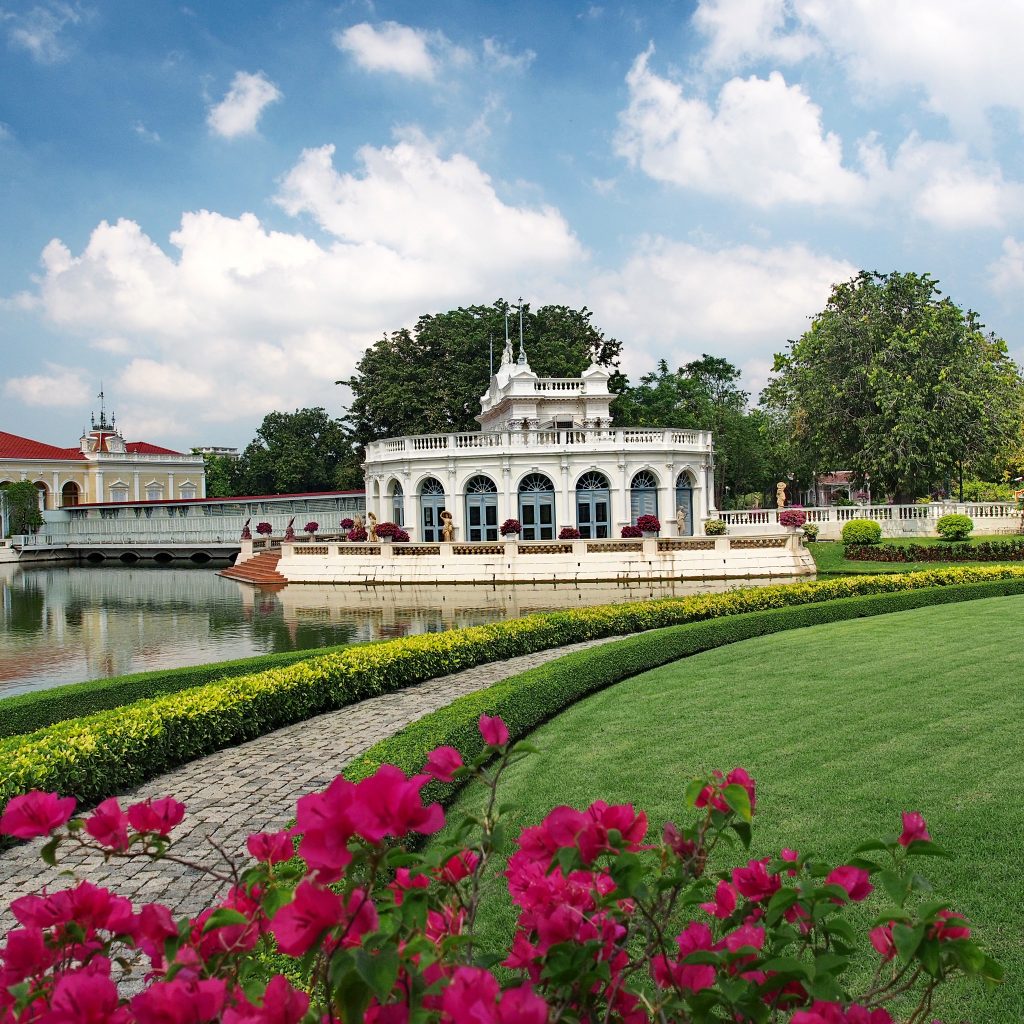
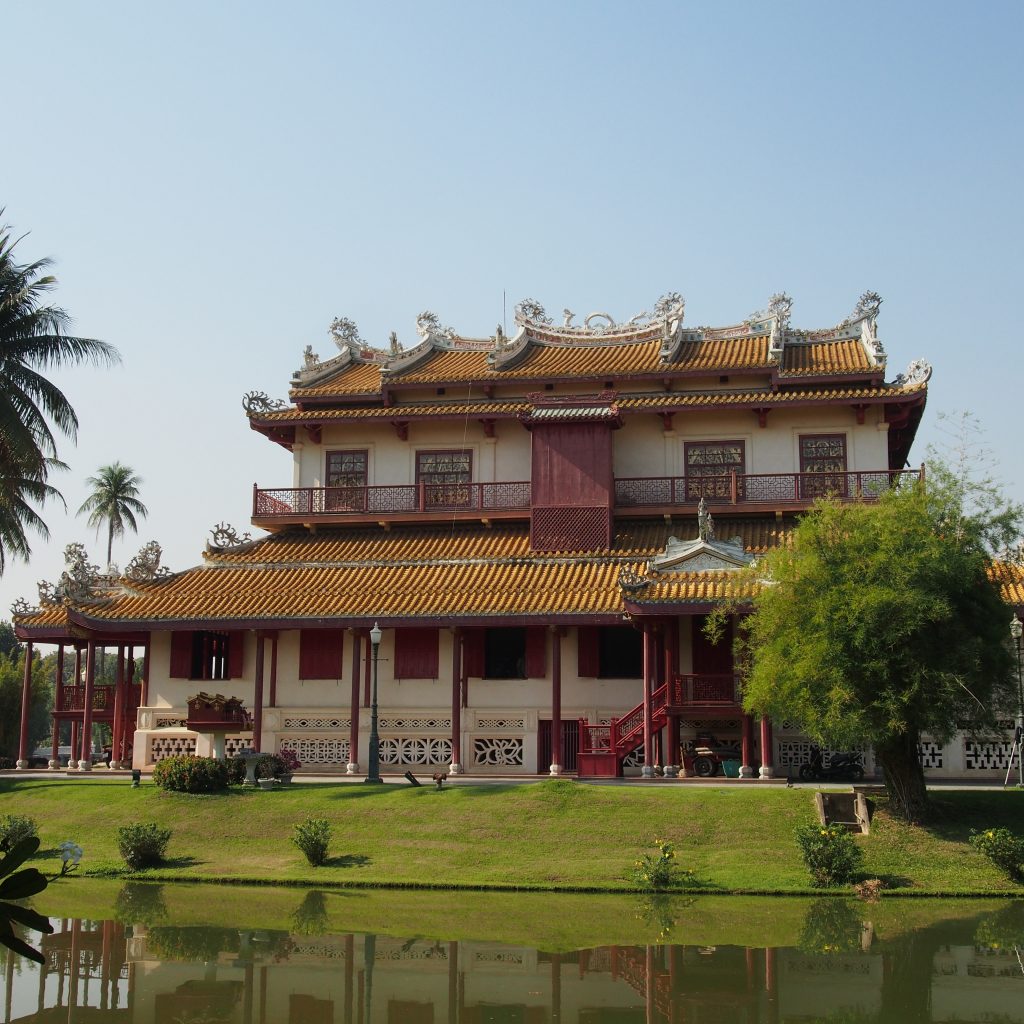
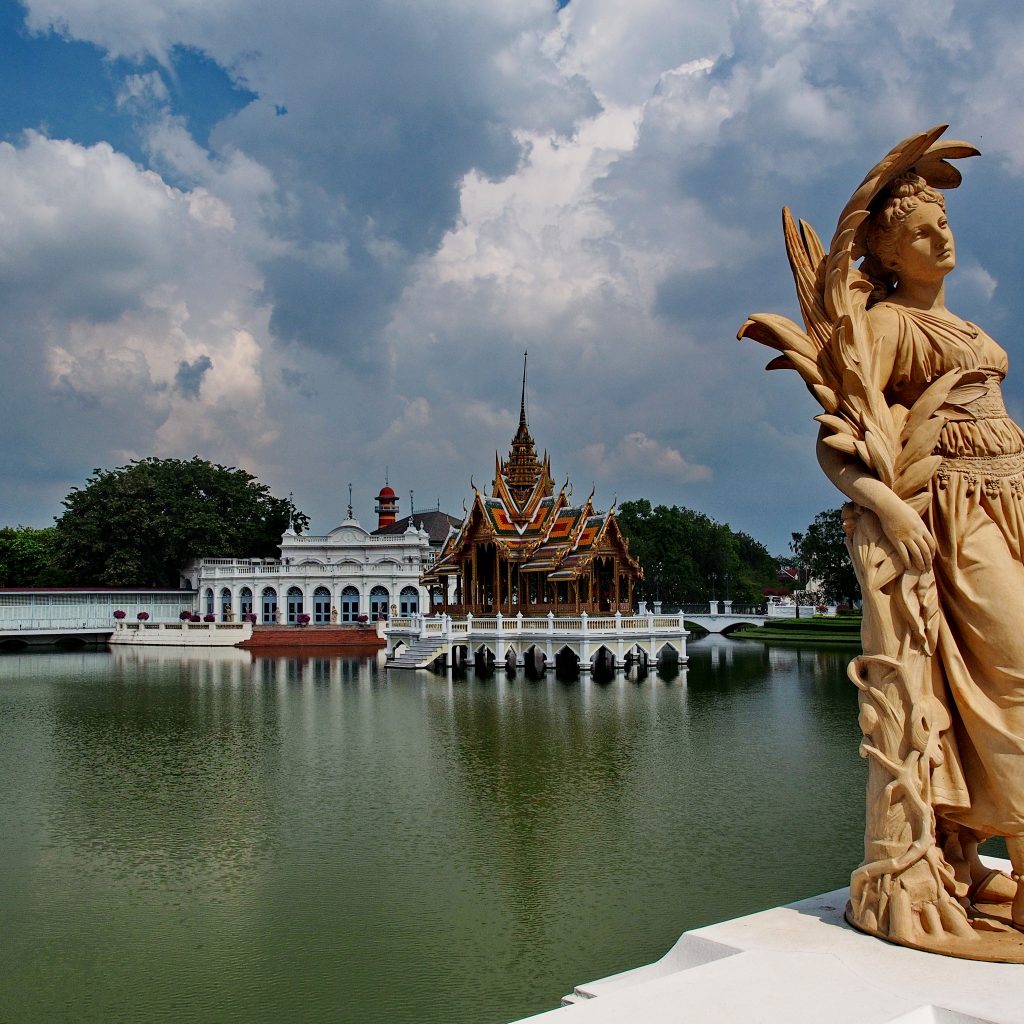
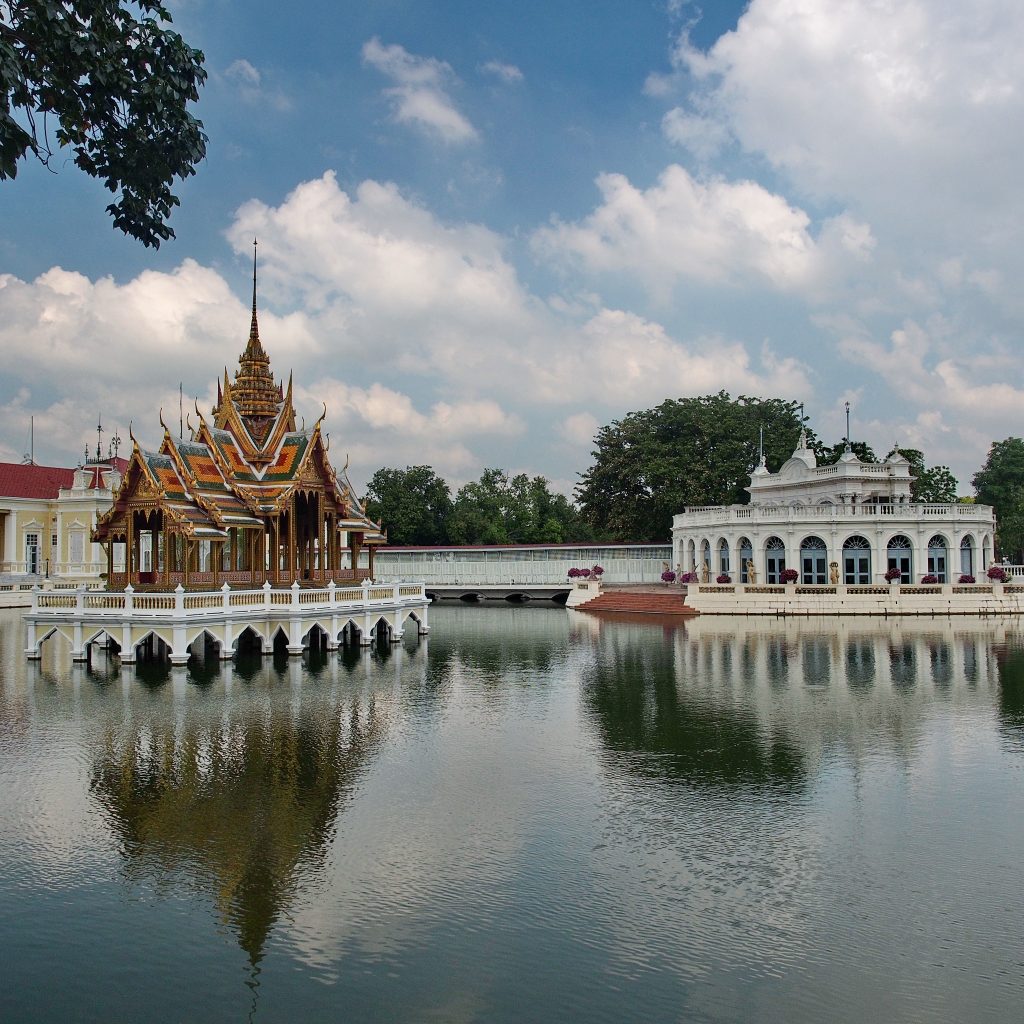
Roti Sai Mai: the sweet treat of Ayutthaya
Since the old days, Ayutthaya is a cultural melting pot. One of the best you should not miss while visiting the old capital is Roti Sai Mai.
Widely available throughout the City, the Thai-style candy floss or cotton candy is rolled in a paper-thin roti sheet. A bit of salted roti goes well with the sweet and soft cotton candy.
Roti Sai Mai is a dessert with Islamic influences. Its recipe was inherited among Ayutthaya Muslims. The sweet was widely made and sold by Muslim vendors before spreading out to the public nowadays.
Roti from the Indian subcontinent is adapted into a sweet by rolling floss or cotton candy inside it. The thin silky strings are actually spun sugar and they are usually found in various colors. The roti is super thin and made in white or green color. The green color green is from the pandan leaf. Some roti is topped with sesame.
The sweet treat is widely available at street stalls, in the City as well as along the highway. In front of the Ayutthaya Hospital is one of the best places to buy Roti Sai Mai with many stalls you can choose from.
One of the project in the reign of King Bhumibol “Nong Rahan Cheen” for Community based and now they are ready to show to the Tourist as the new attraction in Ang Thong Province.
#CommunityBasedOfTourism #RoyalProject #ReviewAngthong
Credit : https://www.facebook.com/angthong.farm/
#CommunityBasedOfTourism #RoyalProject #ReviewAngthong
